Vermeer-Related Primary Resources
This ongoing study, initiated in February of 2024, is dedicated to gathering as many Vermeer-related textual primary sources as possible, thereby offering a rich and evolving foundation for research. In this endeavor, what is particularly interesting is that many of these resources have been digitized and have made accessible online by websites such as Archive.org and Gallica.bnf.fr. This accessibility opens up new avenues for exploration and analysis, allowing researchers and enthusiasts worldwide to delve into these documents without being constrained by physical location. We warmly welcome criticism and suggestions.
Primary resources are firsthand evidence or documentation directly related to artworks, artists, or specific periods in art history, playing a crucial role in gaining a comprehensive understanding. By collecting primary sources related to Johannes Vermeer's life and art, this study seeks to shed light on his historical context, explore critical reception of his work and enable comparisons with contemporaries. These sources not only reveal the cultural significance of Vermeer's art in his era but also its enduring influence on art history. These resources include:
- Artworks themselves: Paintings, sculptures, installations, and other art forms serve as direct evidence of artistic styles, techniques, and themes from various periods.
- Artists' writings: Diaries, letters, manifestos, and interviews where artists discuss their work, processes, and intentions.
- Contemporary documents: Critiques, reviews, and commentary published during the time an artwork was created or an art movement was active.
- Official records: Documents such as auction catalogues, museum records, legal depositions, and estate inventories.
Secondary resources, in contrast, analyze, interpret, or critique primary sources and events, offering insights one step removed from the original artworks or historical events. They also encompass peer-reviewed publications that feature research articles, theoretical papers, and reviews of current art historical scholarship. Secondary resources are crucial for understanding the broader implications of art and art movements by providing context, analysis, and varied interpretations.
Primary resources provide direct evidence of the past, while secondary resources interpret or analyze that evidence to deepen our understanding of art and its historical context. Thus, primary resources offer a direct glimpse into the past, while secondary resources aim to understand, interpret, or critique artworks and art historical events.
This article greatly benefits from the contributions of John Michael Montias, an American economist and leading biographer of Vermeer, who crafted the most comprehensive portrait of the artist thus far. Through diligent research in the Delft Municipal Archives, Montias combined his passion for the subject with scholarly rigor to uncover new, significant documents. He also reexamined existing documents with fresh insights, shedding light on the Delft master and those who interacted with him in any capacity. "Through his scrupulous analysis of various documents ranging from notes and letters to receipts and legal papers,…Montias "unveiled the layers of Vermeer's life, a favorite and enigmatic artist of his, and one of the world's most mysterious. His work opened the door for a new genre of art history in which artists were analyzed in the context of their social and economic surroundings and not merely their works. "Kathryn Shattuch, "John Montias, 76, Scholar of Economics and of Art, Is Dead," The New York Times, August 1, 2005, accessed November 15, 2023.
Vermeer-Related Primary Resources
- Veen, Otto van. Amorum Emblemata, figuris aeneis incisa. Antwerp: Henrik Swingen, for the author, 1608.
- Record of Vermeer's Baptism: October 31, 1632 | Delft. Nieuewe Kerk (New Church) - Baptismal Register no. 12.
- Leonaert Bramer's Appeal to Maria Thins: April 4, 1653.
- Record of Vermeer's Marriage to Catharina Bolnes: April 5, 1653.
- Vermeer and Gerrit ter Borch Witness an Act of Surety: April 22, 1653.
- Guild Book of Delft Master Painters, Engravers, Sculptors, Potters, etc. in the Seventeenth Century. December 29, 1653.
- "Vermeer is Mentioned as a "Master Painter.": January 10, 1654.
- Declaration Concerning Johan van Santen with the Signatures of Johannes Vermeer and His Wife, Catharina Bolnes: December 14, 1655.
- Vermeer and His Wife Catharina Bolnes Contract a Loan of 200 Guilders from Pieter van Ruijven: November, 30, 1657.
- Johannes Vermeer Leases Mechelen: January 4, 1672.
- Vermeer's Family Leaves Nothing to the Camaer van Charitate: December 16, 1675.
- Vermeer's Funeral Casket is Held by 14 Pallbearers: December 16, 1675.
- Monconys, Balthasar de (1611–1665). 2 vols., Lyon, 1665–1666.
- Bleyswijck, Dirck van. Beschryvinge der stadt Delft. Printed by Arnold Bon, bookseller on the Marct-velt, Delft, vol. 1 and 2, Delft 1667 and 1680.
- Van Berkhout, Pieter van Berkhout - Fragments of the diary of Pieter Teding van Berkhout, Koninklijke Bibliorheek, The Hague. May 14. 1669.
- Sysmus, Jan (Johannes). Schildersregister (Register of Painters). 1669–1678.
- Lairesse, Gérard de Lairesse. Groot schilderboek (The Great Book of Painting). 2 volumes. Amsterdam: Willem de Coup and Petrus Schenk, 1707.
- Hoet II, Gerard. Catalogus of naamlyst van schilderyen met derzelver pryzen, zedert een langen reeks van jaaren zoo in Holland als op andere plaatzen in het openbaar verkogt, benevens een verzameling van lysten van verscheyden nog in wezen zynde cabinetten. 3 vols. The Hague, 1752–1770.
- Le Brun, Jean-Baptiste Pierre. Galerie des peintres flamands, hollandais et allemands, Paris, 1792–1796.
- De Vries, Jeronimo. Notes on Vermeer, 1813.
- Van Eynden, R. and Van der Willigen, Adriaen. Geschiedenis der vaderlandsche schilderkunst : sedert de helft der XVIII eeuw. 4 vols., Haarlem 1816–1840 (Volume 4, 1816, pp. 164-168).
- Josi, Christiaan. Collection d'imitations de dessins d'après les principaux maîtres hollandais et flamands. Amsterdam and London: Chez C. Josi, 1821.
- Smith, John. A catalogue raisonné of the works of the most eminent Dutch, Flemish, and French painters. Supplement vol. 9, London, 1842.
- Théophile Thoré, Etienne Joseph, "Van der Meer de Delft," Gazette des Beaux Arts, Oct. 1, 1866, pp. 297–330; Nov. 1, 1866, pp. 458–470; Dec. 1, 1866, pp. 542–575).
Veen, Otto van. Amorum Emblemata, figuris aeneis incisa. Antwerp: Henrik Swingen, for the author, 1608.
Otto van Veen, also known as Otto Venius (1556–1629), was a Flemish painter and humanist, active in the late sixteenth and early seventeenth centuries. He is best known for his literary works in the Southern Netherlands and for being Peter Paul Rubens' teacher.
Van Veen's Amorum Emblemata is considered to be one of the most important and influential of all emblem books. This work is significant for its combination of images and poetry, serving as a source of inspiration for artists and writers of the time. The collection was designed by Van Veen and first published in Antwerp in 1608 in three polyglot versions: Latin, French, and Dutch; Latin, Italian, and French; and Latin, English, and Italian. Its success and popularity led to many further editions and adaptations, while its images were subsequently used by decorative artists throughout Europe. In producing a book of love emblems, Van Veen was following a trend which began in Amsterdam in 1601 with the publication of Quaeris quid sit Amor, a compilation of twenty-four love emblem prints produced by the artist Jacques de Gheyn with accompanying Dutch verses by Daniel Heinsius. Van Veen's volume is far more comprehensive, consisting of 124 emblems."Otto van Veen: Amorum Emblemata," Special Collections Department, Library, University of Glasgow, acessed February 14, 2024.
An emblem book usually consists of three parts for each entry: an icon; a motto; and an epigram, or text (fig. 1). The icon image is designed to visually represent the central theme or idea of the emblem. The motto is a brief phrase or inscription, often in Latin, serving as a title or summary of the emblem's theme. This motto frames the viewer's interpretation of the image. The epigram poem, prose, or explication that accompanies the image and motto, elaborating on their meaning, often in a moral, philosophical, or allegorical context. Such books were immensely popular among all social classes, and according to the Dutch poet and writer Jacob Cats (1577–1660), their use is that they show "mute pictures which speak…humorous things that are not without wisdom; things that men can point to with their fingers and grasp with their hands."
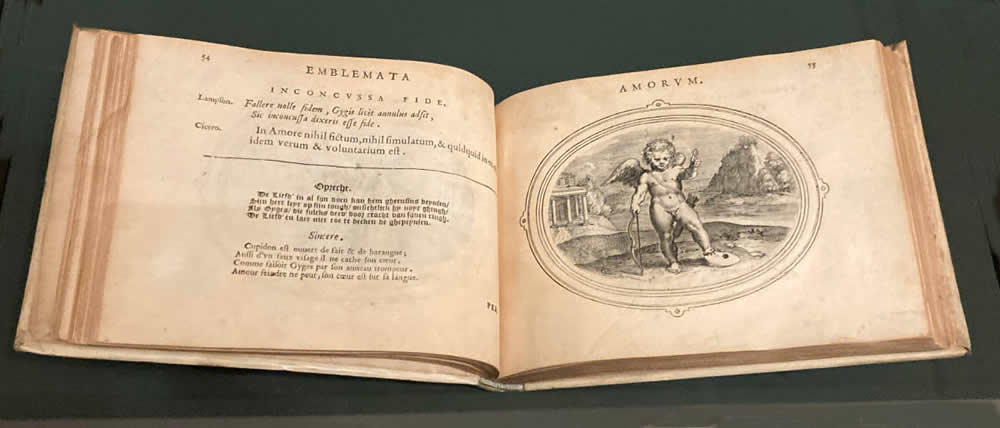 fig. 1 "Amor non est nisi ad unum" Amorum Emblemata (pp. 54-55)
fig. 1 "Amor non est nisi ad unum" Amorum Emblemata (pp. 54-55)Otto van Veen
Engraving, 16.5 x 21 x 2.3 cm.
Antwerp, 1608
Artists found a vast repository of symbols, themes, and narratives in emblem books. The complex interplay of text and image in these books provided a fertile ground for artistic inspiration, enabling artists to draw from a shared cultural vocabulary of symbols and meanings. This practice encouraged a more nuanced and layered approach to visual storytelling, where paintings and sculptures were imbued with deeper symbolic and moral dimensions.
Dutch art historian Eddy de Jongh was the first to identify the likely inspiration behind the ebony-framed Cupid with a raised arm in Vermeer's A Lady Standing at a Virginal (fig. 2)—an engraved motto contained in Van Veen's Amorum Emblemata, "Perfectus a mor non est nisi ad unum" (Love is not perfect except to one) (fig. 3). In Vermeer's painted version, Cupid holds aloft a small card bearing the Roman numeral "I," referring to the emblem's caption. De Jongh suggested that Vermeer's inclusion of this motif likely alludes to the concept of fidelity in love, although he notes that it remains unclear whether the admonition is directed towards the standing musician or the spectator. Interestingly, the card held by Cupid in Vermeer's painting is blank, which, if intentional, may have further nuanced the story's meaning. However, the numeral may have degraded over time or been removed during previous restorations.
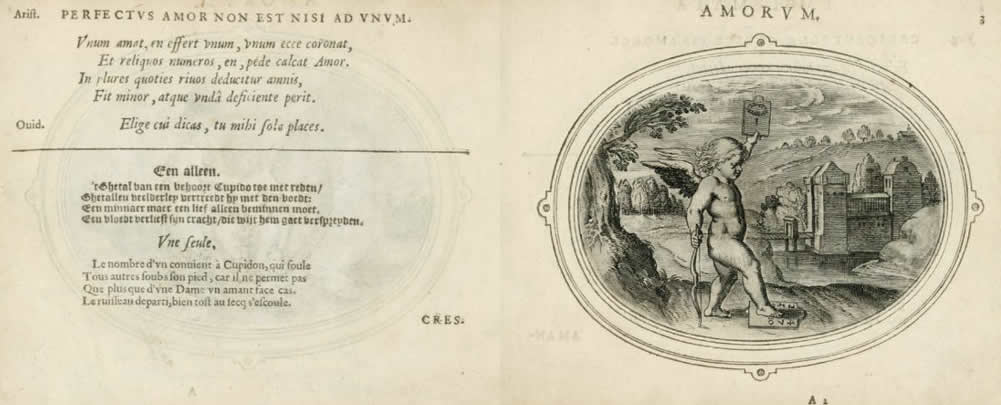 fig. 3 "Perfectus a mor non est nisi ad unum" Amorum Emblemata (pp. 2-3)
fig. 3 "Perfectus a mor non est nisi ad unum" Amorum Emblemata (pp. 2-3) Otto van Veen
Engraving, 16.5 x 21 x 2.3 cm.
Antwerp, 1608
 fig. 2 A Lady Standing at a Virginal (detail)
fig. 2 A Lady Standing at a Virginal (detail) J ohannes Vermeer
c. 1670–1674
Oil on canvas, 51.7 x 45.2 cm.
National Gallery, London
 fig. 4 Girl Reading a Letter by an Open Window
fig. 4 Girl Reading a Letter by an Open Window Johannes Vermeer
c. 1657–1659
Oil on canvas, 83 x 64.5 cm.
Gemäldegalerie Alte Meister, Dresden
Additionally, the Cupid not only bears resemblance to Van Veen's engraving but also resembles standing puttos first identified by German art historian Gustav Delbanco in 1928. Delbanco observed similar figures in the classicist works of the Alkmaar artist Cesaer van Everdingen (1616/17–1678), a prominent history painter of the time. While art historians continue to endorse Delbanco's claim with some reservations, the repeated depiction of the same painting, which unfortunately has not survived, over a long period makes it highly probable that Vermeer had access to this contemporaneous work, as he depicted other two other paintings, likely owned by his mother-in-law, Maria Thins, in his works over the years.
For more than 250 years, Vermeer's Girl Reading a Letter at an Open Window (fig. 4) was seen standing in front of a bare gray wall. Following the painting's restoration between 2017 and 2021, a meticulous restoration procedure uncovered the Cupid, making it starkly visible once again. The existence of an overpainted picture-within-the-picture had been known about since 1979. What is new is the discovery that the overpainting of the Cupid picture was not done by Vermeer himself.
Differences in detail between the Dresden Cupid and the last version in A Lady Standing at a Virginal have led art historians to contemplate the exact nuance of meaning of the Cupid painting in the Dresden piece. The newly revealed Cupid portrays the figure striding forth triumphantly, trampling over one of two masks cast upon the ground—details conspicuously absent in A Lady Standing.In an earlier work, A Maid Asleep, one of the masks had been depicted as a pile of debris. The iconographical significance of the Cupid is believed to be inspired by another emblem in Van Veen's Amorum Emblemata, "Inconcussa fide," where Cupid is depicted in a similar posture (fig. 5). "Inconcussa fide" is a Latin phrase that translates to "Unshakeable Faith" or "Unwavering Trust" in English. It conveys the idea of steadfastness, reliability, and trustworthiness. Thus, in the specific context of Vermeer's Girl Reading a Letter at an Open Window. Thus, the Cupid in Girl Reading a Letter at an Open Window likely symbolizes the enduring and sincere nature of true love, steadfast and trustworthy in the face of challenges or temptations. One notable exclusion in Vermeer's rendition is that in Van Veen's emblem Cupid holds up the ring of Gyges in his raised hand, a detail possibly obscured by the curtain in Vermeer's painting. According to legend, the ring renders its wearer invisible. According to the text associated with Van Veen's emblem, true love transcends deceitful games, being founded on sincerity and honesty.
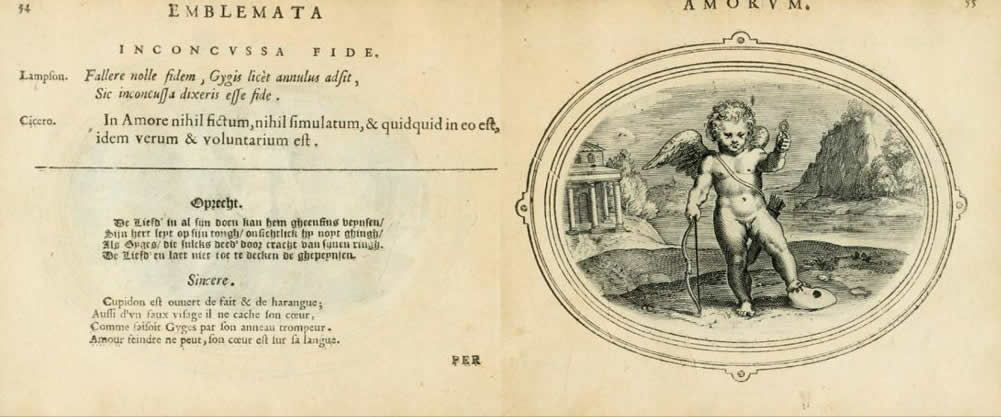 fig. 5 "Inconcussa fide" Amorum Emblemata (pp. 54-55) Otto van Veen
fig. 5 "Inconcussa fide" Amorum Emblemata (pp. 54-55) Otto van VeenEngraving, 16.5 x 21 x 2.3 cm.
Antwerp, 1608
Whatever its meaning, Van Everdingen's work must have held significant importance for the artist, as it appears in the background of earlier works, such as A Maid Asleep and Girl Interrupted in Her Music, in different guises—a total of four times—making it one of Vermeer's favorite props..
Therefore, Vermeer's Cupid painting was likely not an artistic fabrication but a real painting mentioned as "a Cupid" in the inventory of his widow's possessions in 1676.
Vermeer's Baptism: October 31, 1632 | Delft. Nieuewe Kerk (New Church) - Baptismal Register no. 12
![Nieuewe Kerk (New Church) - Baptismal Register no. 12, October 31. 1632) <em> dito. 1 kint Joannis, vader Reynier Janssoon, moeder Dingnum Balthasars, getuijgen P[iete]r Brammer, Jan Heijndricxzoon & Maertge Jans</em>.](primary-sources-images/baptism_a_full.jpg) fig. 6 Nieuewe Kerk (New Church) - Baptismal Register no. 12, October 31. 1632) "dito. 1 kint Joannis, vader Reynier Janssoon, moeder Dingnum Balthasars, getuijgen P[iete]r Brammer, Jan Heijndricxzoon & Maertge Jans."
fig. 6 Nieuewe Kerk (New Church) - Baptismal Register no. 12, October 31. 1632) "dito. 1 kint Joannis, vader Reynier Janssoon, moeder Dingnum Balthasars, getuijgen P[iete]r Brammer, Jan Heijndricxzoon & Maertge Jans."Almost exactly a year after Reynier Jansz (Vermeer's father) was inscribed in the Guild of Saint Luke, the future artist was born to him and his wife, who were living on the Voldersgracht, twelve years after the birth of their first child, Gertruy. At this time, Digna Baltens, Vermeer's mother, was thirty-seven, and Reynier, his father, was forty-one years old. The new child was christened "Joannis" at the Nieuwe Kerk (New Church) on October 31, 1631, and his baptism was recorded in a vellum-bound church register, in a vellum-boundVellum is a fine-quality writing surface made from animal skin, historically used for manuscripts, documents, and the bindings of books. The term is derived from the Latin word "vitulinum" meaning "made from calf," leading to the English term "vellum," which originally referred to calf skin. However, over time, the term has come to encompass a broader range of animal skins, including those from sheep, goats, and other animals. church register (fig. 6 & 7).
John Montias's research reveals that Vermeer's baptismThe entry for Vermeer's birth in October 1632 and the entry for the famous Delft scientist and "father of microscopy" Antonie van Leeuwenhoek's on the same month (November 4) appear on the same page of the baptismal records book of the Nieuwe Kerk (New Church), He was registered as "Thonis Philipszoon." was somewhat of a break from the past. The ceremony was witnessed by a certain Pieter Brammer (a skipper), Jan Heijndricxzoon (a framemaker), and Maertge Jans. Neither Bramer nor Heijndricxzoon were likely family members, an unusual occurrence. The only certain family member was Maertge Jans, Reynier's sister. In the other baptisms of Reynier's siblings all were witnessed by close relatives.
An additional anomaly was the choice of Vermeer's first name, "Joannis," a Latinized form of "Jan" favored by Roman Catholics and upper-class Protestants. Reynier may have had ambitious plans for his first male child. However, on informal occasions, he was likely known as "Jan."
 fig. 7 Nieuewe Kerk (New Church) - Baptismal Register no. 12, October 31. 1632) "dito. 1 kint Joannis, vader Reynier Janssoon, moeder Dingnum Balthasars, getuijgen P[iete]r Brammer, Jan Heijndricxzoon & Maertge Jans."
fig. 7 Nieuewe Kerk (New Church) - Baptismal Register no. 12, October 31. 1632) "dito. 1 kint Joannis, vader Reynier Janssoon, moeder Dingnum Balthasars, getuijgen P[iete]r Brammer, Jan Heijndricxzoon & Maertge Jans."Vermeer, instead, was not an uncommon name. The name was sometimes spelled "'van der Meer" in documents by notaries and public officials, which means "from the lake," though neither Reynier nor his son preferred this variant. In 1667, when referred to as "Johannes van der Meer, artful painter" in a legal document, the painter himself signed as "'Johannes Vermeer." In 1670, during the division of Reynier and Digna's estate, lawyer Frans Boogert initially wrote their son's name as "Johannes van der Meer" but later crossed out "van der Meer."
Aside from his paintings, all traces of Vermeer have disappeared from the period between his baptism in October 1631 and his betrothal in April 1653. About all we can say with near certainty is that young Johannes grew up in his father's inns, first at The Flying Fox on the Voldersgracht, then at the Markt in Mechelen on Markt, with only one sibling, a sister twelve years older than himself. The rest is speculation.John Michael Montias, Vermeer and His Milieu: A Web of Social History (Princeton, NJ: Princeton University Press, 1989), 98.
Montias entry 136John Michael Montias, Vermeer and His Milieu: A Web of Social History (Princeton, NJ: Princeton University Press, 1989).
Dutch transcription (Montias 1993, 136): 31 October, 1632. dito. 1 kint Joannis, vader Reynier Janssoon, moeder Dingnum Balthasars, getuijgen P[iete]r Brammer, Jan Heijndricxzoon & Maertge Jans. (Delft G. A., New Church, "Doopboek" no. 12; first published by Obreen F.D.O. Obreen, "Iets over den Delftschen schilder Johannes Vermeer," Archief voor Nederlandsche Kunstgeschiedenis, vol. 4 (1881–1882), 289–303. 1881, 4: 291.)
Leonaert Bramer's Appeal to Maria Thins: April 4, 1653
On the evening of April 4, 1653, at the request of Jan Reijniersz. [Vermeer] and Trijntgen Reijniers [Catharina Bolnes], the well-known Delft Catholic painter Leonaert Bramer (1596–1674) and the Protestant Captain Bartholomeus Melling, who served as Sergeant-major in Brazil and later as a flag-bearer for the States General, called on Maria Thins, Vermeer's future mother-in-law,Melling had been a captain and sergeant in Brazil, and was later an ensign in the service of the States General of the Dutch Republic. He probably belonged to the dominant Reformed religion so Montias suggests he may have represented the Protestant and Bramer the Catholic side in the confrontation with Maria Thins. Aside from Captain Melling, documents link Vermeer with two other individuals who were Captains. Shortly after his wedding, Vermeer and Gerrit ter Borch, served as witnesses at a deposition concerning Johan van den Bosch, Captain in the States General, stationed in Den Briel. On Jan. 10, 1654, Vermeer signed a document with Lambertus Morleth, Captain in the town of Clacken in the Land of Cleves called on Maria Thins, Vermeer's future mother-in-law.This document also suggests that Vermeer's network of friends included both Catholics and Protestants. They had with them a Delft lawyer named Johannes Ranck. This party had come to convince Maria that the young up-and-coming artist was a good match for her beloved daughter Catharina. Maria's sister was also present giving support and sympathy. Captain Melling may have represented the Protestant and Bramer the Catholic side in the confrontation with Maria Thins.The name of Melling, who frequented well-eslablisllcd Delft merchants, appears in a number of Delft documents.
"The visitors had come to ask Maria to sign a document permitting the marriage vows to be published. Maria replied that she would not sign such an act of consent. Despite this a subtle distinction —she would put up with the vows being published—she said several times that she wouldn't stand in the way of this (fig. 8 & 9). In other words, she didn't welcome the marriage but she wouldn't block it.
"The following morning the notary Ranck drew up a deed attesting to Maria Thins' sufferance of the vows being published, and this was witnessed not only by Bramer and Melling but by a man named Gerrit van Oosten and Delft lawyer Willem de Langue, De Langue was a serious picture collector, at whose house Vermeer might have seen works by, among others, Rembrandt, Roelandt Savery, and Bramer. both of whom had frequent dealings with the Bramer and Vermeer families."John Michael Montias, Vermeer and His Milieu: A Web of Social History (Princeton, NJ: Princeton University Press, 1989), 216
Montias entry 249 John Michael Montias, Vermeer and His Milieu: A Web of Social History (Princeton, NJ: Princeton University Press, 1989).
Dutch transcription (Montias 1993, 249):
5 \d\sFebruary\s\d 1653.
Op huijden den 5den april 1653 compareerde voor mij Johannes Ranck openbaer notaris…binnen der stadt Delft residerende in presentie van de ondergeschreven getuijgen, Capiteyn Melling out ontrent LIX jaeren ende Leonart Bramer schilder out ontrent LVIII jaeren beyde burgers alhier, die verclaerden ende attesteerden ten versoucke van Jan Reijniersz. ende Trijntgen Reijniers waerachtich te weesen dat sij getuijgen neffens mijn notaris gisteren avont sijnde den IIII den deser sijn geweest ten huijse aen ende bij de persoon van Joffrouwe Maria Tints woonende alhier…
[signed:]
B. Melling
W. de Langue
Leonaert Bramer
Gerrijt IJansz. van Oosten
Johannes Ranck notaris Anno 1653
akte 55
(Delft G. A. records of notary J. Ranck, no. 2012)
Record of Vermeer's Marriage to Catharina Bolnes: April 5, 1653.
On April 5, 1653, Vermeer's impending marriage to Catharina Bolnes was registered at Delft's city hall. Two weeks later, on Sunday, 20 April, the couple married in Schipluy (today Schipluiden), approximately an hour's walk from Delft. Catharina came from a relatively well-off Catholic family from Gouda, which was notable since Vermeer's family was Protestant. Before she married Vermeer, Catharina Bolnes lived with her mother, Maria Thins. The marriage is generally believed to signify the artist's conversion to Catholicism, marking a significant decision in the context of the religiously divided Dutch Republic of the seventeenth century." In terms of distance, the move from the inn of Vermeer's father on Markt to Oude Langendijk was just a little more than 100 meters for Vermeer. But his marriage had transported him into a very different milieu. Maria Thins' house was in the Papenhoek (Papists' Corner), where many of Delft's Catholics lived. At that time too, approximately a quarter of the population of Delft were Catholic. Partly under pressure from Reformed Church clergy, the governors of the city of Delft took a range of measures to suppress Catholicism in the city. However, they were also acutely aware that many Catholics made a significant contribution to the city's economic life. So Catholics were permitted to continue to practice their faith, provided this was invisible to the rest of society."David de Haan, Arthur K. Wheelock Jr., Babs van Eijk, and Ingrid van der Vlis, Vermeer's Delft (Zwolle: Waanders Uitgevers, Museum Prinsenhof Delft, 2023), 28.
Catharina's mother, Maria Thins, would be particularly influential in their lives, providing them with financial support and, eventually, housing them in her home. This home also served as Vermeer's studio, where he painted many of his most famous works.
Vermeer's own parents were married in 1615 in Amsterdam before Jacobus Taurinus (1576–1618), a famous Calvinist and Orthodox Reformed Church Minister. Although their marriage arrangement would seem to imply a commitment to the Reformed faith, neither of them was officially registered as a member of the faith which would have given them the right to participate in the sacrament of communion and an obligation to educate themselves in the doctrinal issues as well as a public confession of faith. Therefore, it appears likely that Vermeer's parents were part of a sizable group known as "supporters," individuals who, for various reasons, did not comply with the strict membership requirements or were averse to religious discipline.
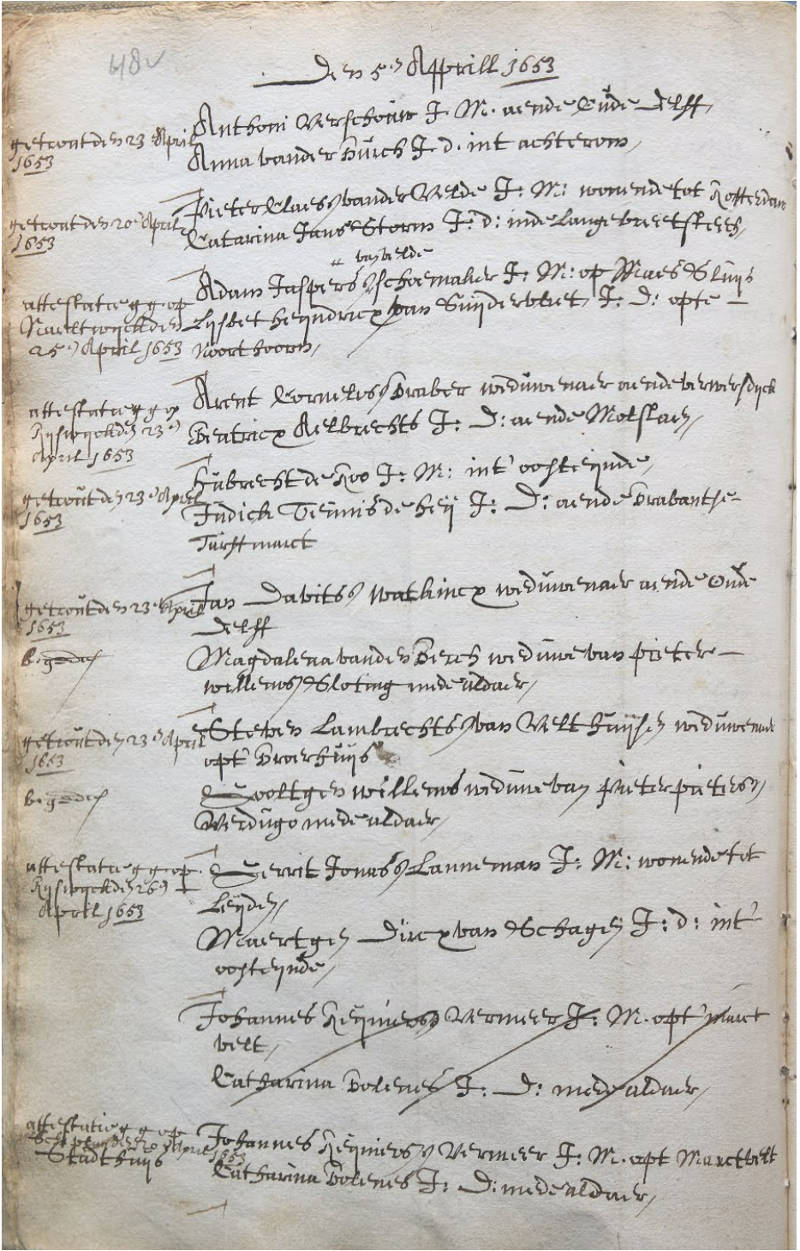 fig. 10 Register of the persons who entered the holy marital state in the town of Delft, beginning with the year 1650, ending "last" [31st] December, 1656.
fig. 10 Register of the persons who entered the holy marital state in the town of Delft, beginning with the year 1650, ending "last" [31st] December, 1656. The next morning the notary Ranck drew up a deed attesting to Maria Thins' sufferance of the vows being published (fig. 10 & 11), and this was witnessed not only by Bramer and Mellling but by a man named Gerrit van Oosten and the Delft lawyer Willem de Langue, who had frequent dealings with the Bramer and the Vermeer family. De Langue had a significant collection of paintings including works of Rembrandt and Bramer.
Maria likely sought to adhere to the counsel of local Catholic officials, who recommended that parents discourage their children from marrying outside the Catholic faith. This rare insight into Vermeer's private life reveals that the aspiring painter had notably gained the esteem of distinguished artists and prominent Delft citizens.
Vermeer's marriage is documented in a record dated April 5, 1653, with a marginal note specifying the small town of Schipluy—now Schipluiden—as the location of the union. Although the marriage banns were published in Delft, the young couple had requested a certificate allowing them to be joined in Schipluy where Catholicism remained well entrenched. Due to restrictions,In the 17th century, the Netherlands was a country undergoing significant religious, social, and political changes, which influenced the practice and recognition of Catholic marriages. The Union of Utrecht (1579) guaranteed freedom of conscience and private worship but did not extend to public practice of the Catholic faith. As a result, Catholic public worship was banned, and churches were taken over by Protestants. Catholic marriages, like other aspects of Catholic life, were often conducted in secret or in private chapels due to restrictions on public Catholic ceremonies. Although Catholic marriages were performed according to the rites of the Catholic Church, they were not legally recognized by the Protestant authorities. This lack of legal recognition could affect issues of inheritance, legitimacy of children, and other legal matters. Catholic weddings were not held publicly, often taking place in barns or similarly discreet locations. When Vermeer married Catharina Bolnes, in essence, he became de facto part of a Roman Catholic family and a Roman Catholic neighborhood with its advantages and disadvantages.
![5 en 20 April, 1653. Den 5en Apprill 1653: Johannes Ryniersz. Vermeer J[ong] M[an] opt Marctvelt, Catharina Bolenes J[onge] D[ochter] mede aldaar. [margin note left-side:] Attestatie gegeven in Schipluijden 20 April, 1653 5 and 20 April, 1653.](primary-sources-images/marraige-detail.jpg) fig. 11 5 "en 20 April, 1653. Den 5en Apprill 1653: Johannes Ryniersz. Vermeer J[ong] M[an] opt Marctvelt, Catharina Bolenes J[onge] D[ochter] mede aldaar. [margin note left-side:] Attestatie gegeven in Schipluijden 20 April, 1653 5 and 20 April, 1653."
fig. 11 5 "en 20 April, 1653. Den 5en Apprill 1653: Johannes Ryniersz. Vermeer J[ong] M[an] opt Marctvelt, Catharina Bolenes J[onge] D[ochter] mede aldaar. [margin note left-side:] Attestatie gegeven in Schipluijden 20 April, 1653 5 and 20 April, 1653."Following his marriage, Vermeer appeared to distance himself from his own family, with none of his children receiving names from his side as was customary. Instead, the name of Maria was given to the first child in honor of Maria Thins and the Virgin Mary. Another daughter, Elizabeth, was perhaps named after Catharina's aunt who had become a nun in Flanders. The name Ignatius was undoubtedly chosen to honor Saint Ignatius Loyola, the founder of the Jesuit order. Vermeer's first son, Johannes, eventually pursued a vocation as a priest.
Despite Vermeer's family being of lower social status than the Bolneses—a fact Maria Thins likely knew, including the involvement of Vermeer's grandfather in a counterfeit ring, narrowly escaping beheading—the young painter managed to alleviate her considerable anxieties. Maria's own marriage had been full of domestic violence and ended with a divorce. Perhaps the close ties that Maria Thins' family had with the successful Delft painter Leonaert Bramer guaranteed the artist's prospects.
In any case, it would appear that Maria comprehended Vermeer's artistic calling. Throughout the couple's married life, she consistently enhanced her daughter's financial position and supported the young painter's children, and his activity as an artist.
Montias entry 250John Michael Montias, Vermeer and His Milieu: A Web of Social History (Princeton, NJ: Princeton University Press, 1989).
5 en 20 April, 1653. Den 5en Appril 1653: Johannes Ryniersz. Vermeer J[ong] M[an] opt Marctvelt, Catharina Bolenes J[onge] D[ochter] mede aldaar.
[margin note left-side:] Attestatie gegeven in Schipluijden 20 April, 1653 5 and 20 April, 1653.
In the "register of the persons who entered the holy marital state in the town of Delft, beginning with the year 1650, ending 'last' [31st] December 1656 ":
"Johannes Reijniersz. Vermeer, bachelor [living] on the Market Place; Catharina Bolenes
young daughter [spinster], also there. "
[marginal note left-side:] Attestation given in Schipluij, 20 April, 1653."
Vermeer and Gerrit ter Borch Witness an Act of Surety: April 22, 1653.
On April 22, 1653, Johann van den Bosch, a captain in the service of the States General stationed in Den Briel, offered surety to enable Juffr. Dido van Treslong to collect 1,000 guilders owed to her from the estate of the late Lord of Treslong, former Governor of Den Briel (fig. 12 & 13). Van den Bosch guaranteed restitution of the sum if necessary.
"Gerrit ter Borch (1617–1681), painter of elegant society pieces at the time, and the just-married Vermeer, were also there. Were Vermeer and Ter Borch witnesses who happened to be present when the document was drafted, or was either man connected with Captain van den Bosch or Dido van Treslong? No link can be documented, but it would not be surprising to find that Vermeer knew Van den Bosch via Captain Bres, who later settled in Den Briel, or via his uncle, Lieutenant Reynier Balthens."John Michael Montias, Vermeer and His Milieu: A Web of Social History (Princeton, NJ: Princeton University Press, 1989), 102. No other connections between the two artists can be established. In fact, when the American economist and Vermeer biographer John Michael Montias discovered this document, it was not even known that Ter Borch had ever set foot in Delft.
The elder painter signed "Geraerdt Ter Borch," the younger "Johannis Vermeer." The notary referred to Ter Borch as "Monsieur" a sign of his respect for the thirty-six-year-old artist who was then at the height of his powers. Vermeer, instead had not yet an accepted master of the Delft Guild of Saint Luke. As Vermeer had been married just two days earlier to Catharina Bolnes, it is possible that the elder painter had come expressly for the event.
"Ter Borch signed his name below Van den Bosch's in a large and firm hand. Vermeer's signature, just below Ter Borch's, is smaller and more timid, as befitted a younger confrere who was not yet a master in the guild (fig. 13). The two artists may have met fortuitously that day at the notary's, but it seems much more likely that they were previously acquainted."John Michael Montias, Vermeer and His Milieu: A Web of Social History (Princeton, NJ: Princeton University Press, 1989), 102.
Montias entry 251John Michael Montias, Vermeer and His Milieu: A Web of Social History (Princeton, NJ: Princeton University Press, 1989).
(Delft GA, records of Notary W. de Langue, no. 1695.)
Guild Book of Delft Master Painters, Engravers, Sculptors, Potters, etc. in the Seventeenth Century. Part 1: 1613–1649.
On December 29, 1653, at the age of 21, Vermeer joined the Delft Guild of St. Luke (fig. 14, 15 & 16) , initially paying just one guilder and ten stuivers out of the six-guilder incomstgelt (entrance fee), settling the balance in 1656. Historians note that, contrary to the expected half-rate of three guilders for the son of a guild member who might also serve as an apprentice to a Delft guild painter for at least two years, he was charged six guilders. The young artist may not have received the discounted rate because his father, Reynier, although a longstanding guild member, was an constvercoper (art dealer), not a professional painte. Alternatively, if Reynier had recently passed away at that time, this could have affected the fee. Another possibility is that the higher fee of six guilders was applied because Johannes was seen as having studied outside of town. This suggests Vermeer could demonstrate several years of apprenticeship under a master, though the specific painter or painters from whom Vermeer learned his trade remain unknown. Well-known painters Pieter de Hooch (1629–in/after 1679) and Carel Fabritius (1622–1654), and the painter Leonaert Bramer, were also members of the guild as master painters. Fabritius, who joined the guild in 1652, was not a member for long, however.
Guild membership enabled Vermeer to sell his paintings and mentor apprentices. Initially without a meeting place, the guild likely convened in members' homes or local inns. In 1661, they acquired the former chapel at the Oude Mannenhuis alms-houses. By 1667, after significant renovations, the Guild's premises were permanently established at Voldersgracht number 21, where Vermeer would later serve as headman. After it had undergone significant renovations it reopend in great cerimony in 1667. The structure's rear faced direcly Mechelen , whereVermeer's family had resided, presnting a view of its facade over the canal. In addition to painters, the Guild included glassmakers, potters, printers, tapestry makers, printmakers, and sculptors among its members. Conversely, artisans like silversmiths had their own separate guild. The administration of St. Luke's Guild comprised six headmen, with three new headmen elected annually.
The dissolution of the guilds during Napoleon I's reign led to the destruction of all registry documents. Nonetheless, a vital record has survived: a small booklet preserved at the Royal Library in The Hague. However, a singular vital record has survived this purge: a diminutive booklet, now safeguarded within the Royal Library in The Hague.
The Royal Library booklet is of particular historical significance as it includes entries in Vermeer's own handwriting. Vermeer's tenure as headman across four one-year terms—1662, 1663, 1670, and 1671—during which he personally registered new members, underscores his leadership and active involvement in the guild.Kaldenbach, Kees. "The Delft St Luke Guild: How it was Run." Johannes Vermeer Info. Accessed February 15, 2024.
Vermeer is Mentioned as a "Master Painter": January 10, 1654.
January 10, 1654, Vermeer is mentioned for the first time as Meester-schilder (Master painter) indicating he had by this time improved his professional and social status (fig. 17 & 18).Johan Michael Montias, who has examined the guild's records, reckons the number of master painters in Delft to have been forty-seven in 1613, fifty-eight in 1640 (the peak for painters), fifty-one in 1660, and thirty-one in 1680. Printers, not painters, generally formed the wealthiest profession. But as the century passed the faience-makers were those who showed the greatest increase in numbers: in 1650 there were thirteen of them, when there were fifty-two painters; in 1680 there were fifty-seven faience-makers and, as noted, thirty-one painters. New potteries were being set up, many in former breweries. Anthony Bailey, Vermeer: A View of Delft (New York: Holt Paperbacks, 2002), 89. Another witness was a certain Captain Morleth from the Duchy of Cleves. It raises the question of whether it was mere coincidence that Vermeer's name appeared alongside those of military officers in four consecutive legal documents: Sergeant-Major Melling during his engagement; Captain van der Bosch when he jointly witnessed with Ter Borch; his uncle, Lieutenant Baltens, the very next day; and Captain Morleth only a few months afterward.
Montias entry 258John Michael Montias, Vermeer and His Milieu: A Web of Social History (Princeton, NJ: Princeton University Press, 1989).
(Delft G.A. akten van notaris N[icolaes] Vrijenbergh, no. 2052.)
In the detail below "Vermeer Meester-schilder" is circled in light brown, further below is the painter's signature.
Three pages. Page 3 (signatures), third line from below (text) + f.:
'Lambertus Morleth & Johannis
Vermeer M[eester]=schilder…'
[signed]:
Lambertus Morleth
Johannis Vermeer
Vrijenbergh, Notaris
1654
DECLARATION CONCERNING JOHAN VAN SANTEN WITH THE SIGNATURES OF JOHANNES VERMEER AND HIS WIFE: CATHARINA BOLNES: December 14, 1655.
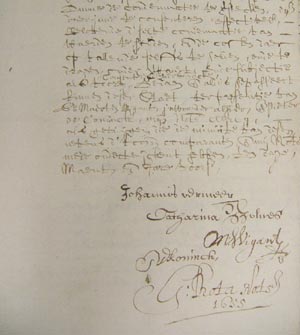 fig. 19 Archival record of declaration concerning Johan van Santen with the signatures of Vermeer and his wife Catharina Bolnes.
fig. 19 Archival record of declaration concerning Johan van Santen with the signatures of Vermeer and his wife Catharina Bolnes.This document, discovered by Abraham Bredius a century ago, was dated December 14, 1655 (fig. 19 & 20). "On this day, Sr. Johannes Reijnijersz. Vermeer, master painter," and his wife "Juffr. Catharina Bolnes," appeared before Notary Rota to guarantee a debt of 250 guilders, which the artist's father had contracted in 1648 from a sea captain named Johan van Santen.ohan van Santen, the son of Cornelis van Santen, a prominent member of the Reformed Community and a regent of the Delft Orphanage, and the brother of the military officer and playwright Gerrit van Santen, later became a captain of the Delft militia commanding the orange-pennant shooters ("orange vendel schutters"). He was forty-four years old when he guaranteed the loan. In 1655, three years after the death of Reynier Jansz., Johannes Vermeer and his wife Catharine Bolnes discharged Captain Johan van Santen of his guarantee and undertook to repay the loan themselves. If Reynier Jansz. had access, via Johan van Santen, to the milieu of Johan's brother Gerrit, this might have been very valuable to him in his art-dealing activity. The playwright, who died in 1656, was friendly to some of the most eminent collectors and art lovers of Delft. In the 1610s, he dedicated one of his plays to Boudewijn de Man, who owned what was perhaps the finest collection of paintings in Delft, and another to Maria van Bleiswijck, who belonged to one of the two or three most eminent "regenten" families in Delft and appears to have been a patroness of the arts. It is also possible that Johan van Santen introduced Vermeer into this artistic circle. John Michael Montias, Vermeer and His Milieu: A Web of Social History (Princeton, NJ: Princeton University Press, 1989), 77. Nine years later, Digna Baltens and Vermeer, who had acquired the obligation after Reynier's death, were still paying the interest on this debt. The "Sr." (signior or seigneur) preceding Vermeer's name signifies the artist's rise in social status. It will be recalled that Vermeer's father was never addressed in such a manner in any of the numerous documents pertaining to him.John Michael Montias, Vermeer and His Milieu: A Web of Social History (Princeton, NJ: Princeton University Press, 1989), 134.
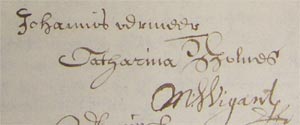 fig. 20 Archival record of declaration concerning Johan van Santen with the signatures of Vermeer and his wife Catharina Bolnes with their signatures (detail).
fig. 20 Archival record of declaration concerning Johan van Santen with the signatures of Vermeer and his wife Catharina Bolnes with their signatures (detail).
Montias entry 262John Michael Montias, Vermeer and His Milieu: A Web of Social History (Princeton, NJ: Princeton University Press, 1989).
Dutch transcription after the English explanation (Montias 1993, 262):
14 december, 1655. Op huijden den xiiiien December xviC vijfenvijftich, Compareerden voor mij Govert Rota openbaer Notaris… Sr. Johannes Reijnijers. [crossed out: Vosch] Vermeer Mr. schilder, ende Juff. Catharina Bollenes, wonende binnen deser stadt, sijne huijsvrouwe, Te kennen gevende ende verclarende sij comparanten, dat de E. heer Johan van Santen, Cap[itey]n vant Orange Vendel schutters, binnen deser stadt opten vijftien* [correct: 5] December xvi C. Achtenveertich sich selven, borge ande mede principael onder behoorlijcke renunchiatie hadde geconstitueert,…
[signed:]
Johannis Vermeer
Catharina Bolnes
M[aerten] Wigant [witness]
Pieter de Koninck [clerk]
G. Rota [notary]
(Delft G. A., records of Notary J. Ranck, no. 1986, vol. 257.)
Vermeer and His Wife Catharina Bolnes Contract a Loan of 200 Guilders from Pieter van Ruijven: November 30, 1657.
 fig. 20 Archival record of Vermeer and his Wife Catharina contract a loan of 200 guilders from Pieter van Ruijven.
fig. 20 Archival record of Vermeer and his Wife Catharina contract a loan of 200 guilders from Pieter van Ruijven.
This document provides the first definitive evidence of contact between Vermeer and his future patron, Pieter van Ruijven. Van Ruijven lent Vermeer and Catharina 200 guilders at an extremely low interest rate (fig. 20 & 21) . According to John Montias, this may have served as an advance for the purchase of one or more paintings.
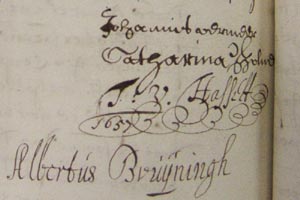 fig. 21 Archival record of Vermeer and his Wife Catharina contract a loan of 200 guilders from Pieter van Ruijven (detail).
fig. 21 Archival record of Vermeer and his Wife Catharina contract a loan of 200 guilders from Pieter van Ruijven (detail).
Montias entry 271John Michael Montias, Vermeer and His Milieu: A Web of Social History (Princeton, NJ: Princeton University Press, 1989).
30 November, 1657. [200 guilders on loan by Pieter Clasz. van Ruijven]
Op huijden den lesten November anno XVIC sevenvyfftich, Compareerden voor my Joan van Ophoven openbaer Notaris…mitsgaders voorden naegenoemde getuygen Johannis Reyniersz. Vermeer schilder, ende Catharina Reyniers Bolnes syne huysvrou…
[signed:]
Johannis Vermeer
Catharina Bolnes
(T. v. Hallitt ? 1657)
Albertus Bruijningh [clerks as witnesses]
Joan van Ophoven, Notaris, 1657
Johannes Vermeer Leases Mechelen: January 4, 1672.
Like his father, Johannes Vermeer was also an art dealer. From 1672, he also derived income from leasing Mechelen, which he had inherited
following his mother’s death (in 1670). On January 4, 1672, he leased it to Johan van der Meer, an apothecary, for a period of six years (fig. 22 & 23). This lease began on May 1 of the current year, with an annual rent of 180 guilders. Vermeer signed this formal legal document, confirming the agreement.
The document highlights Vermeer's shift towards a Latin writing style, marked by his adoption of the Latinized first name "Joannes." This change likely signifies Vermeer's effort to align with the cultural trends of his era.
Montias entry 340John Michael Montias, Vermeer and His Milieu: A Web of Social History (Princeton, NJ: Princeton University Press, 1989).
On January 4, 1672, Johannes Vermeer leased the house known as "Mechelen," located on the north side of the Market Place, at the southwestern corner of the Oudemanshuis street, to Johan van der Meer, an apothecary, for the next six years. The lease was set to commence on May 1 of the present year, at a rate of 180 guilders per year. (Delft G.A., records of Notary F. Boogert, no. 2008, first published in Bredius [910, p. 62.)
Vermeer's Family Leaves Nothing to the Kamar van Charitate: December 16, 1657.
"On December 16, 1675, the day Vermeer's coffin was placed in the family grave, an inscription was made under his name in the book recording death notations to Delft's Kamer van Charitate (Chamber of Charity) (fig. 24 & 25). The inscription in Dutch read: niet te halen, which may be translated as "nothing to be got." The reference was to the box that was normally sent to the house of the deceased. In this box, his family or heirs were supposed to deposit his "best outer garment" or a suitable donation for the poor.
About half of the required income of the Kamer van Charitate came from donations, the rest from land ownership and various levies that have to be paid by the citizens of Delft. Thus, the Kamer received "additional cents" on the city taxes on the sale of real estate, wine, and peat. A very creative levy was that of the so-called "best outer garment." The most expensive clothing item from the estate of every deceased resident had to be handed over. From time to time, sales took place at the auction house, after which the proceeds flowed into the Kamer's coffers. Relatives were free, however, not to hand in the garment itself but to pay an amount determined by the appraisal of the auction house master, up to a maximum of one hundred guilders." "Bij Vermeer is niets te halen," Erfgoed Delft Stadsarchief. March 22, 2021. Accessed February 24, 2024. When Vermeer's mother and sister Gertruy died in 1670, the heirs (Vermeer and Antony van der Wiel) donated 6 guilders and 6 stuivers to the Commissioners for each of the deceased, a modest enough contribution but about average for a lower-middle-class family in Delft.John Michael Montias, "Chronicle of a Delft Family," in Vermeer, edited by Albert Blankert, Gilles Aillaud, and John Michael Montias, (Woodstock and New York: Overlook Duckworth, 2007).
Yet, why was no donation made after the artist's death? Was it because the widow, burdened with so many children, was too poor? Or because the family was Catholic and did not wish to contribute to an organization run by Calvinists? Montias suggests that a contribution to the Camer was made after the death of Maria Thins, which would seem to rule out the religious explanation. The failure to donate is most probably rooted in Catharina's insolvency, declared a few months later."John Michael Montias, Vermeer and His Milieu: A Web of Social History (Princeton, NJ: Princeton University Press, 1989), 337
The decision is curious, considering that the posthumous inventory of Vermeer's estate, prepared by his widow Catharina, included valuable items such as a yellow satin cloak with white fur and a black Turkish cloak. Despite the potential to auction these items for charity, the Kamer van Charitateconcluded that it was unable to collect any charitable contributions from his estate. This decision prompts questions regarding their judgment.
Established in 1597 by Delft's city governors, the Kamer van Charitate aimed to support the poor, operating from Schoolstraat behind the Prinsenhof. It engaged in charitable activities such as distributing bread, turf, occasionally clothing, or money. During the seventeenth century, financial hardships or the loss of a family's breadwinner often plunged 11 to 15 percent of Delft households into poverty, necessitating reliance on charity. This was particularly true for women left behind by husbands serving in the military or with the East India Company. In contrast, Vermeer benefited from his mother-in-law's financial support, sparing him and his family from the struggles faced by many others in Delft.
Vermeer's Grave
Vermeer was forty 1672. Several children more were born to him and Catharina in these years: in 1672 a son they called Ignatius; an infant—perhaps stillborn—who died in June 1673 and was buried in the family grave in the Oude Kerk;December 15, 1675. From the register of the Oude Kerk: "Person en die binnen deser Stad Deiff overleden ende in de Oude Kerck als oock daer buijten begraven sijn tsedert den 19 Julij 1671": "Jan Vermeer kunstschilder aen de Oude Langedijk in de kerk. [In the margin:] 8 Me:J:kin.d" ("Jan Vermeer painter on the Oude Langedijk, in the church. [In the margin:] 8 children under age"). and a child whose name we do not know who came into the world in 1674 and lived only four years. All were burried, like Vermeer as well was to be, in a grave in the Oude Kerk that his mother-in-law, Maria Thins, had bought on December 10, 1661.
"Vermeer's own burial involved a rearrangement of the family grave. The infant who had been buried two and a half years earlier was taken out momentarily while Vermeer was lowered into the grave, and then the tiny remains of the child were put on top of its father's coffin. Maria Thins was at home on the Oude Langendijck when she received the last sacrament of Extreme Unction on December 23, 1680. Her neighbour the Jesuit priest Philippus de Pauw anointed her with holy oil and prayed at her bedside. Four days later she was buried in the Oude Kerk. Fourteen pallbearers made a prosperous show of mourning, and a generous donation of twenty-five guilders and four stuivers was given to the Chamber of Charity. The family grave she had bought years before was now designated as "full." It was perhaps just as well Vermeer had gone first because his greatest day-by-day benefactor was no more."Anthony Bailey, Vermeer: A View of Delft (New York: Holt Paperbacks, 2002), 204-210.
Montias entry 358 John Michael Montias, Vermeer and His Milieu: A Web of Social History (Princeton, NJ: Princeton University Press, 1989).
16 December, 1975. 16 dito (second from below):
Johan Vermeer kunst Schilder aen de Oude Langendijck
niet te haelen [= note right-side]
O:K: [Oude Kerk]
Vermeer's Funeral Casket is Held by 14 Pallbearers: December 16, 1675.
The former archivist, The former archivist, Bas van der Wulp, at Erfgoed Delft, the city's cultural heritage department, has recently discovered a burial record of the Oude Kerk that reveals previously unknown details about the funeral of Vermeer on December 16, 1675 (fig. 26) . Notably, Vermeer's coffin was carried by fourteen bearers, and the church bell was rung, indicating a lavish ceremony.The discovery of the funeral note can be considered remarkable, according to the Prinsenhof Museum, in light of the extensive research on Vermeer done by so many scholars for over a hundred years.Van der Wulp himself, who has worked for the archive for 45 years, had never made such a discovery previously.
Similarly, grand funerals were accorded to Vermeer’s brother-in-law, Willem Bolnes, and his mother-in-law, Maria Thins. Maria Thins' funeral even included two bell tolls instead of Willem and Vermeer's one. Given these observations, it is speculated that Maria Thins may have been the benefactor for Vermeer’s funeral expenses. Van der Wulp posits that Thins might have opted to bear the funeral costs, possibly without full knowledge of Vermeer’s dire financial situation, which had worsened markedly after the Rampjaar (Disastrous Year) of 1672, rendering him penniless.
Monconys, Balthasar de. Journal des voyages de Monsieur de Monconys, Conseiller du Roy en ses Conseils d'Estat & Privé, & Lieutenant Criminel au Siège Presidial de Lyon, 2 vols., Lyon, 1665–1666.
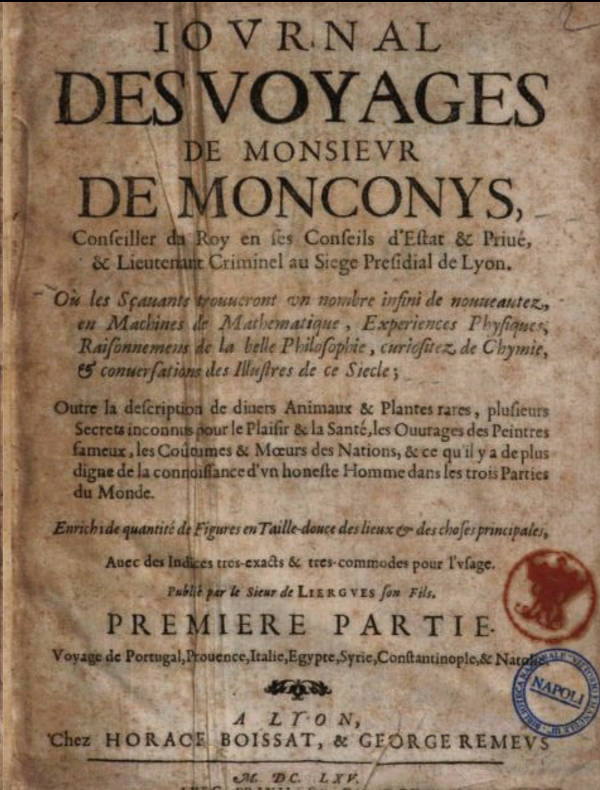 fig. 27 Journal des voyages de Monsieur de Monconys, Conseiller du Roy en ses Conseils d'Estat & Privé, & Lieutenant Criminel au Siège Presidial de Lyon, 2 vols., Lyon, 1665–1666. Balthasar de Monconys.
fig. 27 Journal des voyages de Monsieur de Monconys, Conseiller du Roy en ses Conseils d'Estat & Privé, & Lieutenant Criminel au Siège Presidial de Lyon, 2 vols., Lyon, 1665–1666. Balthasar de Monconys.Balthasar de Monconys (1611–1665) was a French traveller, diplomat, physicist, and magistrate known for his extensive travels and the detailed journal he kept, which was published posthumously as Journal des voyages de Monsieur de Moncony…(fig. 27)
Monconys's journal documents his travels across Europe, the Middle East, and potentially other regions. His travels, conducted during the mid-seventeenth century, occurred in an era notable for significant discoveries and the exchange of knowledge globally. Monconys had a keen interest in science, technology, and art, and his observations reflect a wide-ranging curiosity about the cultures and innovations he encountered. His friends and family, including his son, Gaspard de Monconys de Liergues, sought to impress scholars with the notion of a man of unlimited curiosity.Blaise Ducos, "The 'Tour of Holland'," in Vermeer and the Masters of Genre Painting: Inspiration and Rivalry, edited by Adriaan Waiboer and Eddy Schavemaker (London and New Haven: Yale University Press, 2017), 107. The journal contains detailed observations on natural phenomena, technological inventions, and encounters with eminent scientists, artists, and intellectuals. He often went out of his way to visit scholars, laboratories, and libraries, documenting his findings with a meticulous eye. He was not, however, appreciative of Vermeer's painting (see below), having encountered only one example, (The Milkmaid).
Published posthumously, The Journal des voyages was swiftly acknowledged for its contributions to broadening understanding of the world beyond Europe. His detailed descriptions and analytical approach to what he observed make his journal a significant document for historians studying the period's scientific, cultural, and intellectual history.
In any case, "conditions for travelers in Holland in the latter half of the century, be they aristocrats, people in royal retinues, or well-heeled tourists, were good, and it was easy for artists and liefhebbers (art lovers) to move around the country and to keep abreast of everyone else's work. Monconys's taste for gemstones and his partiality for theoretical science and its development as well as for art are typical of the time. He would not have understood if asked to distinguish between alchemy and chemistry."Blaise Ducos, "The 'Tour of Holland'," in Vermeer and the Masters of Genre Painting: Inspiration and Rivalry, edited by Adriaan Waiboer and Eddy Schavemaker (London and New Haven: Yale University Press, 2017), 107.
Monconys, a man with a trained taste, passionately loved the arts and sciences. Before visiting Delft three times in 1669, where Vermeer worked, he had just come from England where he had met, among others, Thomas Hobbes (1588–1679), the political philosopher; Mr. Reeves, known for constructing telescopes and an acquaintance of the English diarist Samuel Pepys; and Henry Oldenburg (c. 1618–1677), secretary of the Royal Society. Monconys had also attended the society's proceedings with Constantijn Huygens (1596–1687), Dutch diplomat, poet, and scholar (he was also secretary to two Princes of Orange: Frederick Henry and William II, and the father of the scientist Christiaan Huygens).
When Vermeer was born in Delft in 1632, the city was already more than 350 years old. In those times, Delft was a prosperous, if conservative, Dutch town located in the south of the United Provinces, in the province of Holland. It had survived devastating fires and various bouts with the plague but it boasted a long and distinguished past. It was not only the home of the famous School of Delft of painting, but also a thriving center for the decorative arts: tapestry, silver, and faience, or Delft Blue, (click here for a detailed timeline of Delft).
In 1657, when the twenty-one-year-old painter began to exercise his profession, Delft had about 22,000 inhabitants. It had a near-rectangular shape whose longer side runs roughly from south to north, about 1.3 kilometers long and 0.75 kilometer wide. It was surrounded by medieval walls, eight armed gates to discourage potential invaders, and a navigable moat that branched out to the rest of the Netherlands, one of which led to Rotterdam and, via the Maas River, to the North Sea. Internally, Delft was crisscrossed by a series of canals flanked by tree-lined streets. Foreigners often remarked on the city’s lovely architecture, peaceful atmosphere, salubrious water, and exceptional cleanliness.
Getting around Delft required no particular means. A walk from Vermeer's studio on Oude Langendijk to his father’s inn, Mechelen, where the young painter had grown up, took a bit more than two minutes—another 40 footsteps got him to the front steps of the Guild of Saint Luke, the guild of Delft’s artists and artisans in which Vermeer served two times as dean. To check in on the latest progress of Peter de Hooch, one of the most talented painters living in Delft and probably a friend, required about four minutes. To the house of the renowned scientist and lens-maker Antonie van Leeuwenhoek, about two and a half minutes. One of the longest walks he took was to the Hooikade, where he painted the epic View of Delft from the second-story room of a long-lost inn: twelve minutes by foot.
In the seventeenth century, every ambitious European painter aspired to travel to Italy, and especially to Rome, where Raphael, Michelangelo, and Leonardo da Vinci had established and practiced the fundamental rules of the art of painting. None of the great masters responsible for the rise of Dutch painting, however, felt the need to go to Italy. Esaias van de Velde, Jacob van Ruisdael, Frans Hals, Vermeer, Jan Steen, and Rembrandt stayed in Holland close to their own culture. Vermeer is documented to have taken various business trips to Gouda, and once to Amsterdam, on behalf of his mother-in-law, Maria Thins. However, it is hard to imagine that the painter, whose work shows an awareness of cutting-edge art movements, would not have traveled more extensively to the thriving art centers of Dutch art—which were relatively near one another—to seek out fellow artists to exchange ideas and inspect their latest works first hand.
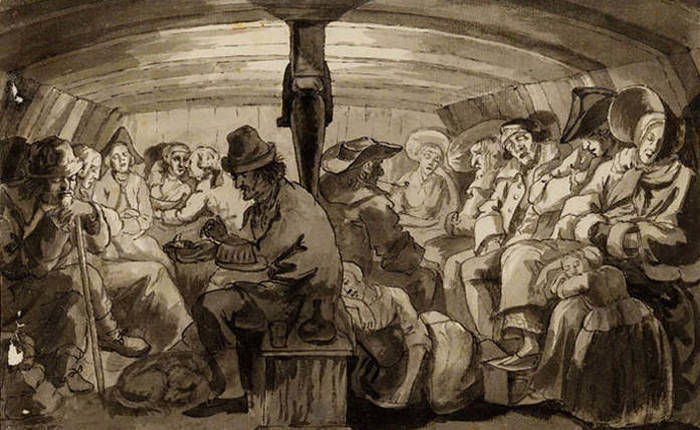 Inside a trekschuit
Inside a trekschuitBy the time Vermeer became active as a painter, the Netherlands had developed a vast and highly efficient transportation system of canals, which connected all the major cities. The horse-drawn trekschuit was so efficient that one could travel from Delft to Rotterdam in an hour and forty-five minutes, with departures every hour. Travel by trekschuit was immensely popular because other than being reliable, comfortable, and cheap, it was also possible to travel safely in any weather. It was so popular that it is portrayed many times in Dutch paintings, including Vermeer’s own View of Delft, which exhibits the artist’s familiarity, if not sympathy, with trekschuit travel. In the left-hand lower corner of the painting, a typical covered trekschuit rests silently moored along the triangular body of water on the south side of Delft, called the Kolk. Vermeer portrays the front of the boat with a reddish canopy formed by a tarpaulin stretched over hoops that protected second-class passengers from intermittent drizzle and rain. Out of sight, on the back of the ship, was a wooden deckhouse for first-class travelers. Six figures, including an infant, are stationed on the sand quay waiting peacefully for the arrival of the schipper, the horse, and the jagertje who will carry them to The Hague or Leiden. Vermeer must have taken a trekschuit from this very spot many times.
In front of the trekschuit, two men speak to an elderly woman, all soberly dressed. Each of the men wears a black, wide-brimmed hat made of felted beaver fur, which at the time arrived in Europe via French traders operating in North America. Such hats were fashionable across much of Europe during the period 1550–1850. In Vermeer’s paintings, they appear in the Officer and Laughing Girl and the Glass of Wine. The soft yet resilient hairs of the beaver could be easily combed to make a variety of hat shapes. A good beaver hat could retain its shape when wet. A detail from the lower left of Vermeer's View of Delft shows that he was intimately familiar with towboat travel. To the left, a nurse holds a newborn infant in her arms. Her deferential body language suggests she is their social inferior. Two elderly women stand face to face to the right and converse as they wait. Both wear similar headgear and blue aprons, which appear countless times in Dutch paintings of daily life. The woman to the left carries a basket. Originally, a man stood to the right of the two figures but it was painted out by Vermeer. Such details remind us that Vermeer was indeed a great painter but one who nonetheless experienced the pleasures and pains of ordinary life like anyone else.
In 1633, a quarter of a million people were transported by trekschuits. The number increased significantly as time passed. The speed was only about 7 kilometers per hour, which was faster than walking, but far more comfortable than by horseback or by stagecoach—the stagecoach was almost twice as fast, but four to five times more expensive. Roads were, being no more than dirt paths, impossible to use in bad weather. If the trip took too long, the skipper promptly refunded his passengers. But fines were also levied for departing too late; running latecomers were left behind. A typical trekschuit could carry about 20 to 30 passengers. Those who wanted a specific seat or seat cushion had to pay a little extra (one penny). In addition to passengers, trekschuit also carried small cargo, letters, and money.
To reach Amsterdam, Vermeer would have taken an early morning walk to the North side of the Kolk, the harbor on the South-east corner side of Delft where towboats departed for Leiden, Haarlem, and Amsterdam every day following strict schedules. The twelve-hour trip was the longest in the Netherlands, but it was possible to disembark at crossing points and continue with the next shift two hours later, perhaps refreshing oneself with a drink at one of the various inns established along the route. Trips to nearby art centers such as Leiden, The Hague, and Rotterdam, were much shorter, making same-day round trips not only possible but easy. Although fashion may have changed from Vermeer’s time, a glimpse of the life on a towboat can be grasped from two drawings made a few decades after Vermeer died.
It is impossible to know how Vermeer mixed with his fellow travelers, but the ride was smooth enough to sketch a few interesting faces inside the covered cabin, or the slowly moving landscape from a wooden bench on the deck, perhaps while smoking a Gouda clay pipe with the boat’s vigilant skipper. Foreign diarists often remarked on the beauties of the countryside. The French diplomat Balthasar de Monconys, who once visited Vermeer’s studio, thought that with its well-tended waterways lined by trees, beautiful groves, and the picturesque windmills, "the land resembles a pleasure garden rather than plain farmland." He also noticed a large number of swans and wondered why they were ignored by the Dutch.
What kinds of conversations would Vermeer have had? There is less than unanimous consent as to the passengers' behavior and the level of their talk. Samuel Pepys, the English traveler-diarist, approved the conduct of his travel companions and was surprised to note that nearly everyone spoke French. Another Englishman described how traveling Dutch women, however, delighted with lascivious and obscene talk. Another related how he had engaged in a delightful conversation with an attractive young Dutch woman who became uncomfortably forthcoming upon their arrival, giving rise to the suspicion that he had been lured into a sex-for-money scheme. And yet, the fact that so many foreigners and Dutchmen of different classes and different geographical origins who intermingled intimately on the towboats must have had an educational effect on the populace and cemented Dutch national identity, already noted for its high level of public education and tolerance. One unexpected consequence of towboat travel was the birth of a literary sub-genre called schuitpraatjes, or "boat talks or boat prattle," which were so popular that they were sometimes even read aloud during the ride.
Renowned art historian Ben Broos, specializing in seventeenth-century Dutch art, states, "Monconys visited Delft during the summer of 1663. He came initially as a tourist,On Monconys's second vist to Delft on August, Monconys went again to Delft by barge - the fare from The Hague was '2 sols par homme'—and visited the Town Hall. evidently unaware of Vermeer's presence. A few weeks later, he went to pay his respects in The Hague to Constantijn Huygens (1596–1687), an important diplomat, art connoisseur, and theorist of Dutch culture. Monconys admired his art collection and described it in detail in his personal diary."Ben Broos, "Un celebre Peijntre nommè Verme(e)r," in Johannes Vermeer, eds. Ben Broos and Arthur K. Wheelock Jr. (Zwolle: Waanders, 1995).
However, one can only imagine how amazed Huygens must have been to hear that the Frenchman had been in Delft, without visiting Vermeer. Given Huygens' familiarity with leading artists of the time [he personally brokered the sale of two important works by the young Rembrandt van Rijn. Given Huygens' connections, it's plausible he recommended Monconys meet with Vermeer, given the Frenchman's interest for fine art. Subsequently, Monconys visited Vermeer at his home and documented the encounter in his diary, which was published in 1665, the year of his death, noting, (fig. 28):
[…] À Delphes [i.e. Delft] je vis le Peintre Vermer [sic] qui n'avoit point de ses ouvrages : mais nous en vismes un chez un Boulanger qu'on avoit payé six cens livres, quoyqu'il eust qu'une figure, que j'aurois cru trop payer de six pistoles.
(In Delft I saw the painter Verme(e)r who did not have any of his works: but we did see one at a baker's, for which six hundred livres had been paid, although it contained but a single figure, for which six pistoles would have been too high a price.)
![Journal des voyages de Monsieur de Monconys, Conseiller du Roy en ses Conseils d'Estat & Privé,
& Lieutenant Criminel au Siège Presidial de Lyon. Balthasar de Monconys, 2 vols., Lyon, 1665–1666. (vol. 1 [1665], page 148 [top]–149 [bottom])](primary-sources-images/monconys-detail.jpg) fig. 28 Journal des voyages de Monsieur de Monconys, Conseiller
fig. 28 Journal des voyages de Monsieur de Monconys, Conseillerdu Roy en ses Conseils d'Estat & Privé,
& Lieutenant Criminel au Siège Presidial de Lyon
Balthasar de Monconys
2 vols., Lyon, 1665–1666. (vol. 1 [1665], page 148 [top]–149 [bottom])
No one knows precisely why Monconys saw no paintings at Vermeer's house. Some scholars believe that Vermeer, having produced relatively few works, simply had none at the time to show him because they had been bought by his clients and patrons (Pieter van Ruijven and his wife Maria de Knuijt) as soon as they were finished.
Although Monconys only briefly touched upon his perception of Vermeer's work, and deprecated its worth, it is clear from his account that there existed select connoisseurs in prominent circles, Konst-vroede Liefhebbers (experienced art lovers), who were aware of Vermeer's artistic skills. Unfortunately, Monconys made no mention of the style or quality of Vermeer's painting—it appears he judged them exclusively on the basis of the number of hours required to do the work.Ben Broos, "Un celebre Peijntre nommè Verme(e)r," in Johannes Vermeer, eds. Ben Broos and Arthur K. Wheelock Jr. (Zwolle: Waanders, 1995), 48.
Presumably, at that time, a Vermeer painting evidently had the same market value as an authentic work by Gerrit Dou (1613–1675), whom Charles II of England had invited to become his court painter in 1660.
"The brief and lapidary nature of Monconys's diary entry on Vermeer was not influenced by religious differences. Both men were Roman Catholics. Vermeer, who was initially from a Protestant family, converted to Catholicism before his marriage to Catharina Bolnes in 1653. Monconys was baptized in Sainte-Croix and educated by Jesuits in Lyon. Their meeting occurred in Delft's Catholic quarter, the Paepenhoek, and Monconys's interactions with other Dutch artists in various cities suggest that religion did not hinder his artistic explorations. Instead, his motivations were driven by curiosity, a desire to acquire curios, and an interest in people.For De Monconys's visit to Delft see also E. Neurdenburg, "Nog enige opmerkingen over Johannes Vermeer van Delft," in Oud-Holland 66, 1951, 33-44.
"It has also been speculated that social hierarchy might have influenced Monconys' brief and somewhat disappointing assessment of Vermeer and his work. Monconys came from an old Burgundian aristocratic family dating back to the thirteenth century, while Vermeer was an art dealer and painter who gained social standing through marriage to the daughter of a wealthy woman, placing him in a different social stratum. Despite what biographers might suggest, Monconys appeared to take pleasure in associating with high society, which could have colored his view of Vermeer."Blaise Ducon, "The Tour of Holland," in Vermeer and the Masters of Genre Painting: Inspiration and Rivalry, edited by Adriaan Waiboer and Eddy Schavemaker (London and New Haven: Yale University Press, 2017), 109.
Van Berkhout, Pieter Teding van. Fragments of the diary of Pieter Teding van Berkhout, Koninklijke Bibliorheek, The Hague. May 14, 1669.
Apart from the account of the Frenchman Monconys, the only known written eyewitness account of Vermeer's paintings was authored by Pieter Teding van Berkhout (1643–1713) (fig. 29), a young scion of a landed gentry family and son of a governor in The Hague.Van Berkhout owned an art collection, some of which was bequeathed to him by an aunt. His collection was diverse, encompassing not only artwork but also scientific tools such as two cameras obscura and microscopes. In 1674, he moved to Delft and settled in a notable building on Oude Delft, subsequently joining the city's administrative upper echelon. Van Berkhout had gathered and inherited a major fine art collection as well which included 68 paintings: 7 history subjects, 17 landscapes, 10 architectural views, 4 marinescapes, 12 genre paintings, and 4 Still lifes and 14 portraits. Thanks to shrewd investments in property and bonds, he had become a very wealthy man. Van Berkhout had an art collection, part of which he had inherited from an aunt. His interests were broad; his estate included two cameras obscuras, microscopes, and other scientific instruments. In 1674, he relocated to Delft where he moved into a prestigious building on Oude Delft and became a member of the city's administrative elite.David de Haan, Arthur K. Wheelock Jr., Babs van Eijk, and Ingrid van der Vlis, Vermeer's Delft (Zwolle: Waanders Uitgevers, Museum Prinsenhof Delft, 2023), 69.
The young Van Berkhout arrived at Delft from The Hague by boat accompanied by Constantijn Huygens, perhaps, in order to facilitate Van Berkhout's introduction. No other reason is given for Huygens's presence in Delft. However, considering that Huygens was the secretary to a Prince of Orange and acquainted with Rubens and Rembrandt, he may have also been there to see Vermeer. Van Berkhout did not provide clarity on this matter but writes in his diary, in French: "having arrived, I saw an excellent painter named Vermeer, who showed me some curiosities by his hand." A week later, apparently impressed by what he saw, in his diary entry of May 14, 1669, he wrote (fig. 30 & 31),
Le 14 mat 1669 : je fus leve assez matin, parlois a mon cousin Brasser de la Brile, et men fus promene a Delft avec unjacht ou estoit Monsieur de Zuylechem van der Horts et [Monsieur de] Nieuivpoort. Lstant arrive ie vis un excellent peijntre nomme Vermeer, qui me montra quelques curiosites de sa main.
(14 May 1669: I got up quite early, spoke with my cousin Brasser de la Brile, and went to visit Delft in a yacht with Mr. Zuylechem van der Horts and [Mr.] Nieuwpoort. When I arrived I saw an excellent painter named Vermeer, who showed me some curiosities he had executed himself.)
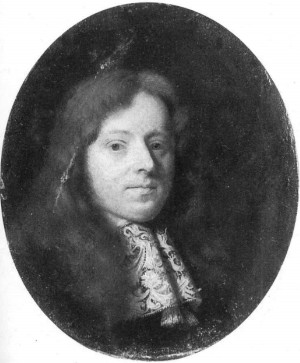 fig. 29 Portrait of Pieter Teding van Berkhout
fig. 29 Portrait of Pieter Teding van Berkhout Casper Netscher
Oil on copper, 13.3 x 11.1 cm.
Teding van Berkhout Foundation, Amersfoort
That Van Berkhout twice visited Vermeer and twice praised him somewhat contradicts romantic notions about Vermeer's social isolation.Ben Broos, "Un celebre Peijntre nommé Verme[er]" in exh. cat. Johannes Vermeer. Arthur K. Wheelock Jr. and Ben Broos, London and New Haven: Yale University Press, 1995, 50.
The journey would have taken an hour-and-a-half to two hours by trekschuit (towbarge) The trekschuit was a relatively swift, comfortable, and reliable mode of transportation which had significant social and political consequences. The trekschuit system greatly enhanced mobility within the Dutch Republic, facilitating easier and more frequent travel for both people and goods. This improved connectivity played a crucial role in the economic development of the region, as it allowed for the quicker and more efficient movement of goods, contributing to the flourishing of trade and commerce. Socially, the trekschuit made it possible for people from different towns and regions to interact more regularly, leading to a greater exchange of ideas and cultural practices. He was accompanied by Monsr. de Zuylichem (Constantijn Huygens) and his friends—a member of parliament Ewout van der Horst (c. 1631–before 1672) and ambassador Willem Nieupoort (1607–1678).Ben Broos, "Un celebre Peijntre nommé Verme[er]" in exh. cat. Johannes Vermeer. Arthur K. Wheelock Jr. and Ben Broos, London and New Haven: Yale University Press, 1995, 50. Huygens was an artistic authority in his own day, maintaining contacts with the famous Flemish painters Peter Paul Rubens (1577–1640) and Anthony van Dyck (1599–1641). He recorded in his diary some remarkably insightful comments about the art of, among others, Rembrandt van Rijn (1606–1669).In December 1669, he visited Caspar Netscher's studio in the court city and "the famous Dou" in Leiden. Earlier in April of the same year, the diarist had visited the Dordrecht studio of Cornelis Bisschop, praised for his excellent perspective in painting. However, as far as we know, Huygens did not visit the Vermeer 's studio. Nonetheless, "The connection between Van Berkhout and Huygens in this instance bolsters the observation…concerning networks of like-minded elites during the seventeenth century. Both men were enormously affluent art lovers and collectors. Both had voracious intellects, owned large personal libraries, had travelled abroad and were fluent in French, the language of high society in the Dutch Republic at this time. They not only shared similar cultural pursuits but also many relatives, friends, and acquaintances. On several occasions,Van Berkhout, his wife, and his sister Jacomina (1645–1711) visited Huygens' country estate, Hofwijck, outside The Hague, as courtesy calls of this sort served important social functions for the well-to-do. In time, relations between these two prominent families were cemented with the marriage in 1674 of Huygens' son Lodewijk (1631–1699) to Jacomina."Wayne Franits, Vermeer (Art & Ideas) (London: Phaidon Press, 2015), 205
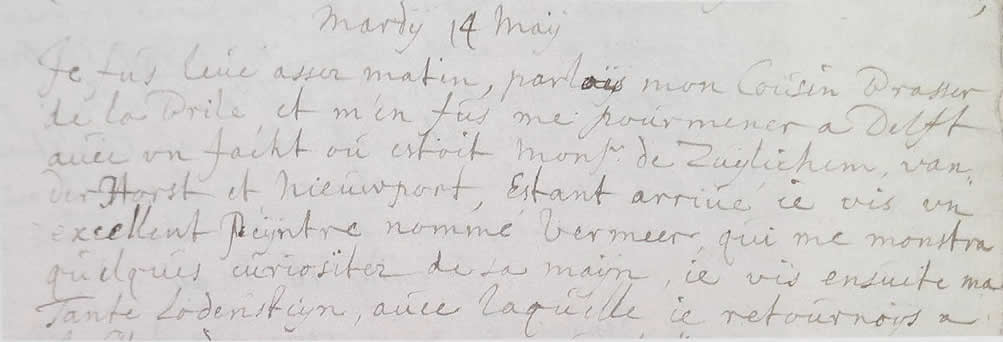 fig. 30 Exerpt from “Journal de mes occupations et rencontres ...,”, 14 May, 166
fig. 30 Exerpt from “Journal de mes occupations et rencontres ...,”, 14 May, 166Pieter Teding van Berkhout
Paper
Kononlijke Bibliotheek, The Hague
People of Van Berkhout's social standing had a deep appreciation for the visual arts as a fundamental part of a gentleman's education. To cater to these enthusiasts, guides such as Pierre Le Brun's Essays on the Wonders of Painting (1635)Jean-Baptiste-Pierre Lebrun, Essai sur les moyens d'encourager la peinture, la sculpture, l'architecture et la gravure, Paris, 1794-1795. were published, informing the reader that in order "to discourse on this noble profession, you must have frequented the studio and disputed with the masters, have seen the magic effects of the pencil [brush], and the unerring judgement with which the details are worked out." "Moreover, the specific language Van Berkhout employed to describe Vermeer's paintings contained essential vocabulary for connoisseurs in the know who excelled at the all- important skill of conducting conversations about art. The diary and Teding van Berkhout's very visits point to the rarefied world of patronage and connoisseurial networks in which Vermeer trafficked."Franits, Wayne. Review of VERMEER, by Pieter Roelofs and Gregor J. M. Weber, eds. Rijksmuseum, Amsterdam, February 10–June 4, 2023. In Renaissance Studies 37, no. 4 (2023). Rijksmuseum/Hannibal Books, 2023.
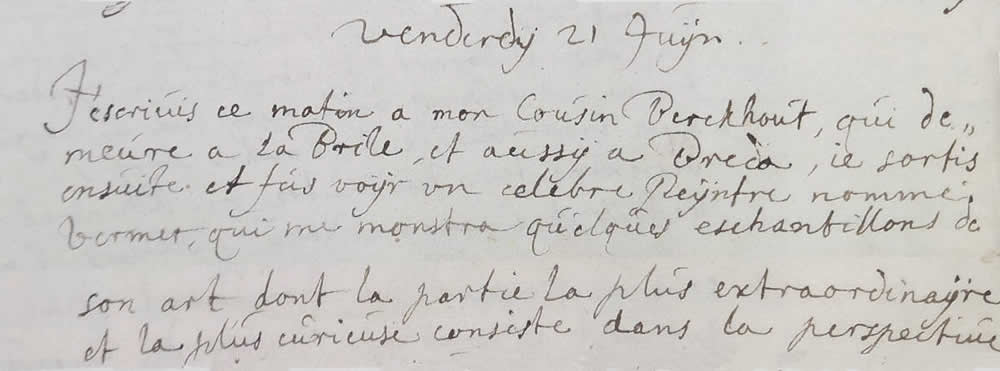 fig. 31 Exerpt from “Journal de mes occupations et rencontres ...,” 21 June 1669
fig. 31 Exerpt from “Journal de mes occupations et rencontres ...,” 21 June 1669Pieter Teding van Berkhout
Paper
Kononlijke Bibliotheek, The Hague
Van Berkhout was also a close acquaintance of Dirck van Bleyswijck, whose Beschryving der Stadt Delft (Description of the City of Delft) had first appeared in 1667. This work contains a now-famous poem by Arnold Bon. In it, Bon laments the untimely death of Carel Fabritius (1622–1654), Rembrandt's most talented pupil, in the explosion of the Delft powder magazine (1654). Despite the loss of Fabritius, Bon praised rising star Vermeer, who "luckily arose" from the fire.
Van Berkhout became a member of Delft Council of FortyThe Delft Council of Forty, or Vroedschap van Delft, was a governing body in the Dutch city of Delft during the Dutch Golden Age. Comprised of influential citizens, it was responsible for local governance, administration, and decision-making. The council played a pivotal role in shaping the city's policies and development, contributing to Delft's prominence as an economic and cultural center during its heyday. With political changes in the late 18th century, the council's influence declined, but it remains a significant part of Delft's historical legacy. from 1675 onwards. In 1674, he lived at Dry Cooningen (Three Magi), Oude Delft number 123. During his lifetime, his wealth in real estate and bonds holdings grew from 90,000 to 475,000 guilders making him exceptionally wealthy. The family also owned an estate just outside Delft. The first six years of his major diary (1669–1713) which is now kept in the Koninklijke Bibliotheek describe his social excursions.Kees Kaldenbach, "Teding van Berkhout," A Rich Tapestry of Multimedia Sources, an Encyclopedic 2000+ Page Web Site on Johannes Vermeer & 17th Century Life in Delft," accessed November 18, 2023.
"In 1669, Van Berkhout was active in the art scene while living in The Hague. Like other discriminating connoisseurs of his era, he made a practice of visiting eminent artists in their studios, including those of several notable artists like Caspar Netscher (1639–1684) in The Hague, Gerrit Dou (1613–1675) in Leiden, and Vermeer in Delft. Additionally, Van Becrkhout explored the collections of art enthusiasts like his cousin Cornelis Boogaert (1640–1679) and others. Van Berkhout's diary entries not only reference specific artworks he saw in these studios and collections, but also describe his visits to "cabinets" or private collections in The Hague. Furthermore, during a trip to Dordrecht, Van Berkhout concluded his business by visiting Johannes van der Hulck, admiring his collection of 'tres Belles peintures.' It is speculated that during this visit, Van Berkhout saw works by Gerrit Ter Borch (1617–1681) and Gabriel Metsu (1629–1667), which were later sold in 1720 at the sale of Van der Hulck's heirs."Piet Bakker, "Painters of and for the Elite," in Vermeer and the Masters of Genre Painting: Inspiration and Rivalry, edited by Adriaan Waiboer and Eddy Schavemaker (London and New Haven: Yale University Press, 2017), 97.
Bleyswijck, Dirck van. Beschryvinge der stadt Delft. Printed by Arnold Bon, bookseller on the Marct-velt, Delft, vol. 1 and 2, Delft 1667 and 1680.
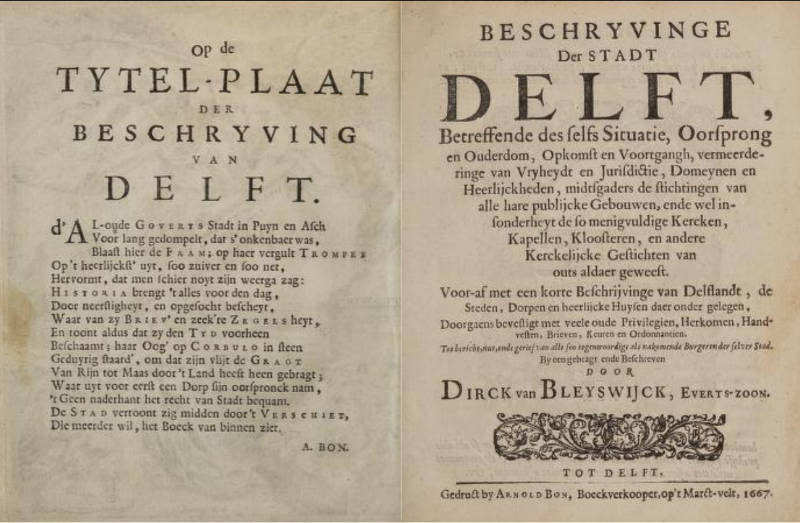 fig. 32 Beschryvinge der stadt Delft
fig. 32 Beschryvinge der stadt DelftDirck van Bleyswijck
Printed by Arnold Bon, bookseller on the Marct-velt, Delft
vol. 1 and 2, Delft 1667 and 1680.
Beschryvinge der stadt Delft (Description of the City of Delft) is a historical work about the city of Delft in the Netherlands (fig. 32). This book was written by Dirck van Bleyswijck and published in 1667. It is significant for providing a comprehensive account of the history, governance, notable buildings, institutions, and customs of Delft during the seventeenth century.
Van Bleyswijck was a notable figure in Delft, and his work is often cited for its detailed descriptions and historical insights into the city's development, its economic and social life, as well as its cultural aspects. Beschryvinge der stadt Delft serves as an important source for historians and researchers interested in the Dutch Golden Age, offering a glimpse into the urban life of a prominent Dutch city of the period.
The book is valuable not only for its historical and cultural content but also for its illustrations, which include maps and views of the city, providing visual documentation of Delft's urban landscape in the seventtenth century. These illustrations are crucial for understanding the spatial organization of the city, its architecture, and its surroundings.
Beschryvinge der stadt Delft is part of a broader genre of city descriptions that were popular in the Netherlands during the sixteenth and seventeenth centuries, contributing to the historical and topographical knowledge of the Dutch Republic. One could still use the maps to get around the center of Delft.
Dirck van Bleyswijck's chronicles show how the thirty-five-year-old Vermeer's exceptional talent was noticed by his Delft contemporaries.
Very few surviving documents link Vermeer's name with his profession.
 fig. 33 Beschryving der Stadt Delft (Description of the City of Delft)
fig. 33 Beschryving der Stadt Delft (Description of the City of Delft) Dirck van Bleyswijck,
Published in 1667 (page 854, last stanza)
Vermeer's name is mentioned twice in Bleyswijck's book. The first (page 859) only mentions his name and birth, 1632, in a list of eminent Delft painters who were still alive at the time the book was being written.
The second mention is in a poem of eight stanzas written by Arnold Bon (before 1634–1691), Van Bleyswijck's publisher. The poem, "Op de droevige, en ongelukkigste Dood van den aller vermaardsten, en konstrycksten schilder, CAREL FABRICIUS," was composed in the honor of Carel Fabritius (1622–1654) who had died in the infamous ammunitions explosion of Delft.
Vermeer's name is lauded in the poem's last stanza. Seven stanzas are printed on page 853, the eighth stanza is printed on page 854.
Soo doov' dan desen Phenix t'onzer schade
In 'tmidden en in 't beste van zyn swier,
Maar weer gelukkig rees' er uyt zynvier
VERMEER, die meesterlyck betrad zyn pade.(Thus did this Phoenix, to our loss, expire,
In the midstand at the height of his powers,
But happily there arose out of the fire
VERMEER, who masterfully trod in his path.)
Art historians have long debated the significance of this brief tribute, attributing multiple meanings to it. The most obvious is that after the death of Fabritius, Vermeer was considered the foremost artist of Delft, a fact that challenges the long-held belief that Vermeer was neglected by his contemporaries. However, some earlier critics interpreted this as an indication that Vermeer had studied under Fabritius, a hypothesis that conflicts with the timeline of Fabritius' stay in Delft and Vermeer's youth. Fabritius moved to Delft in 1650 and died there in the infamous Delft Thunderclap of 1654. The belif that vermeer had apprenticed with Fabritius was baed stylistic affinities amd Bon's description of Vermeer as "following in the footsteps" or "emulating" Fabritius. However, both terms are vague enough to discourage reading in a master/apprentice relationship. Moreover, Fabritius seems to have joined the Delft Guild of Saint Luke more than a year before Vermeer, although he may have been working in Delft before he enrolled in the Guild. Importantly, there is little trace of Fabritius' style in Vermeer paintings until a few years after Fabritius had died in the infamous Gunpowder explosion of Delft while he was painting a portrait.
The Dutch art historian Albert Blankert was the first to note that the poem exists in two different versions, even though there is only one edition of the book. While the last line of the first version reads, "Vermeer, die meesterlyck betrad zyn pade" ("Vermeer who masterfully trod in his path") the line had, at some point, been changed to"Vermeer, die 't meesterlyck hem na kost klaren" ("Vermeer, who masterfully emulated him"). The changes seem to make it clear that Vermeer hadn't simply followed Fabritius' footsteps "but was able to paint as well as he and had succeeded him as Delft's leading painter." Vermeer's name is also mentioned on page 859 which lists painters active in Delft (fig. 34).
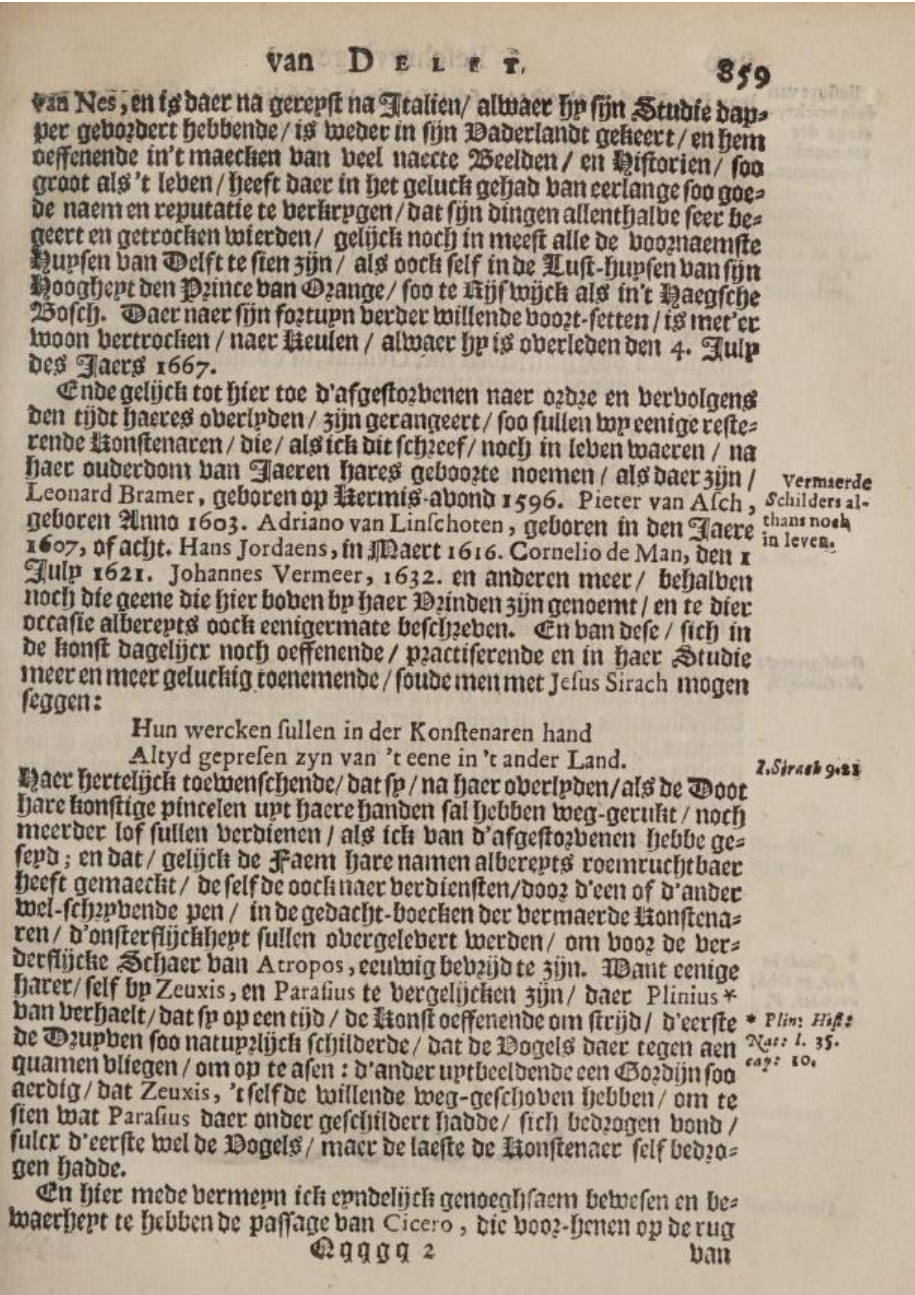 fig. 34 Beschryving der Stadt Delft (Description of the City of Delft)
fig. 34 Beschryving der Stadt Delft (Description of the City of Delft)Dirck van Bleyswijck
Published in 1667 (page 859)
Arnold Bon, the printer of the book and the author of the poem, may have thought of the change himself. But according to Albert Blankert, "it is quite possible that it was suggested by Vermeer, who lived near Bon on the Markt (Market Square). Legal records show that Vermeer's obsession with precision was not restricted to his paintings. In two surviving documents he had his name crossed out and corrected, apparently because he found fault with the spelling. This is particularly remarkable given that Dutch contemporaries often spelled their names in various ways themselves. Vermeer presumably took written statements about himself and his art very seriously, and if he was not satisfied with the first version of the stanza he might well have persuaded Bon to change the typesetting."Albert Blankert. "Vermeer and his Public." in Vermeer, edited by Albert Blankert, Gilles Aillaud, and John Michael Montias, (Woodstock and New York: Overlook Duckworth, 2007), 165. The art historian Arthur K. Wheelock Jr. concurs with Blankert, observing that "the artist was hardly modest in his concepts."Arthur K. Wheelock Jr. and Ben Broos, Johannes Vermeer (London and New Haven: Yale University Press, 1995), 52. At the very least he must have been familiar with stories about artists competing with each other. As far as he must have been concerned, Vermeer versus Fabritius could be added to the list of Apelles versus Protogenes, Raphael versus Michelangelo, Albrecht Dürer versus Lucas van Leyden, and Rembrandt versus Rubens."Ben Broos, "On Celebre Peijntre nommé Verme[e]r," in exh. cat. Johannes Vermeer. Arthur K. Wheelock Jr. and Ben Broos, London and New Haven: Yale University Press, 1995, 52. After all, The Art of Painting, was probably painted in or around 1667, when Beschryvinge der Stadt Delft was published, expressed Vermeer's high ideals about his trade and calling.
Sysmus, Jan (Johannes). Schildersregister (Register of Painters). 1669–1678.
Jan, or Johannes, Sysmus was a seventeenth-century Dutch physician who lived in Amsterdam. However, he is particularly known for a registry or list of painters he recorded during his time between 1669 and 1678 in which he recorded the names of various painters, along with brief descriptions or notes about their work.A. Bredius, "Het schldersregister van Jan Sysmus, Stads-Doctor van Amsterdam," in Oud-Holland 8 (1890), 1-17, 207-234, 294-313; 9 (1891), 137-49; 12 (1894), 160-71; 13 (1895), 112-20.) This registry provides valuable historical insights into the painters and their themes or subjects.
In a handwritten note, one of the most notable mentions in Sysmus's list is a "Van der Meer," which is believed to refer to the renowned Vermeer; "Van der Meer, Jonkertjes en casteelfjes. Delft, hiet Otto." (Van der Meer, small paintings of "dandies" and "little castles." Sysmus incorrectly recorded the artist's first name as "Otto," a common mistake given his frequent inaccuracies with first names. For example, he referred to Leonaert Bramer (1596–1674), the Delft painter and friend of Vermeer's family, as "Adriaen "Bramer."
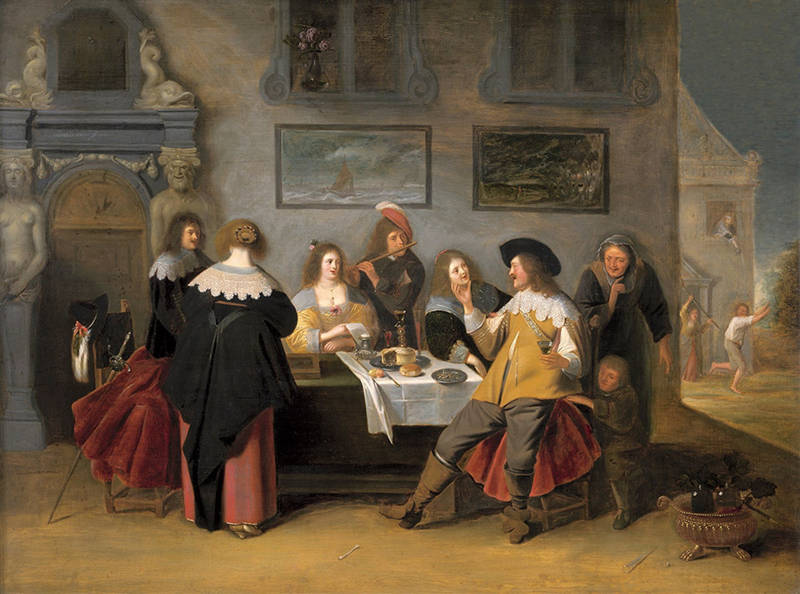 fig. 35 The Prodigal Son in a Brothel
fig. 35 The Prodigal Son in a BrothelChristoffel Jacobsz van der Laemen
c. 1640
Oil on panel, 57 x 74 cm.
Private collection
"What Sysmus meant by 'little dandies' becomes clear when we see that he employed the same word to describe the subjects painted by Caspar Netscher (1639–1684) and Eglon van der Neer (1634–1703). Concerning Christoffel van der Laemen (1606–1622) (fig. 35), he wrote: 'painted foolish little dandies [pinxit malle jonkertjes].' The subject matter of Hieronymus Janssen de Danser (1624-1693) he calls 'little salons filled with little dandies and damsels [zaletjes val jonkertjes en jojfertjes].' Cornelis de Bie, in his 1661 book on The Noble Liberal Art of Painting, characterized the paintings of Van der Laemen, as did Jan Sysmus after him, as "foolish little dandies." Van der Laemen specialized, says De Bie, in "the very nice depiction" of "courtship, dances, and other pleasurable ways of passing time by foolish little Dandies and Damsels ... who are rendered most pleasantly and charmingly." De Bie elaborates in a poem that Van der Laemen's young people are engaged in "foolishness and riotousness," "gorging and a great deal of other craziness," including "teasing and prancing," bass and viol playing, gambling, courting, dancing, "guzzling, swim[ming] in evil, liv[ing] above station," and this "without rule, without moderation [sonder reghel, sonder maet]." Sysmus indicates the themes of Gabriel Metsu (1629–1667), Gerrit ter Borch (1617–1681), and Michiel van Musscher (1640–1705) with just the word "juffertjes."
According to the late art historian Albert Blankert, "Vermeer's jonkers and juffertjes are the young people who appear in most of his works after 1666. Depictions of 'dandies and damsels' in inner rooms were a novelty introduced in the 1620s by Dutch artists like Dirck Hals (1591–1656), Willem Duyster (1599–1635) (fig. 36), and Pieter Codde (1599–1678). In their work, the figures are dressed according to the latest and costliest fashion. They amuse themselves with drinking, eating, music-making, and flirting. The owner and observer of such a painting could delight in the joys of youth."Albert Blankert, "Vermeer and his Public," in Vermeer, edited by Albert Blankert, Gilles Aillaud, and John Michael Montias, (Woodstock and New York: Overlook Duckworth, 2007), 32-22. The fact that Sysmus mentioned casteelties (little castles) as one of Vermeer's themes suggests that he might have been familiar with Vermeer's View of Delft.
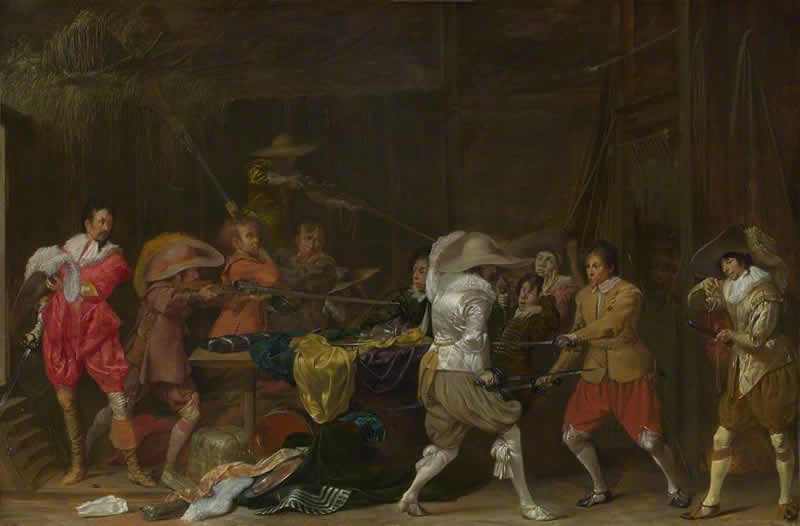 fig. 36 Soldiers Fighting over Booty in a Barn
fig. 36 Soldiers Fighting over Booty in a BarnWillem Duyster
c. 1623-1624
Oil on oak, 37.6 x 57 cm.
National Gallery, London
Lairesse, Gérard de. Groot schilderboek (The Great Book of Painting). 2 volumes. Amsterdam: Willem de Coup and Petrus Schenk, 1707. (PDF in orininal language; English version in 1778)
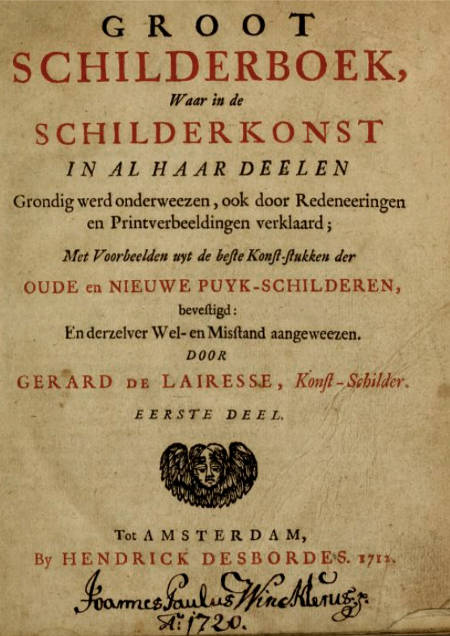 fig. 37 Groot schilderboek (The Great Book of Painting)
fig. 37 Groot schilderboek (The Great Book of Painting)Gerard de Lairesse
Amsterdam: Willem de Coup and Petrus Schenk
1707
Gerard or Gérard (de) Lairesse (1641–1711) was a Dutch Golden Age painter and art theorist. His talents extended beyond painting to include music, poetry, and theater, evidencing his multidisciplinary skills. De Lairesse was influenced by the Perugian Cesare Ripa (c. 1555–1622) and French classicist painters like Charles le Brun (1619–1690), Simon Vouet (1590–1649), and authors such as Pierre Corneille (1564–1616) and Jean Racine (1639–1699). His significance grew in the period following the death of Rembrandt. Lairesse authored influential treatises on painting and drawing, including Grondlegginge Ter Teekenkonst (1701) and Groot Schilderboek (1707) (fig. 37).
The Groot Schilderboek is a comprehensive treatise on art and painting (fig. xx). It covers a wide range of topics related to painting techniques, composition, color theory, and artistic principles.While it served as a painter's manual on its surface, it is remarkably revealing about current social ideologies and their constitutive visual forms, delving into both the technical and conceptual aspects of painting. It had a substantial impact on art education and the development of academic art theory in Europe. Many artists and art students referred to this book for guidance and instruction. As a highly trained and talented painter, de Lairesse was deeply aware of the intricacies of composition and painting techniques, elaborating on them extensively. For example, he wrote "It is remarkable, that, though the management of the colors in a painting, whether of figures, landscape, flowers, architecture, & yields a great pleasure to the eye, yet hitherto no one has laid down solid rules for doing it with safety and certainty…and of color harmony,…good Union and Harmony, is not, to this Day, fixed on certain Principles. Meer Chance is herein our only Comfort."
One of the notable features of the book is its emphasis on a geometric approach to composition and perspective in painting. Lairesse believed that a solid understanding of geometry was essential for achieving harmonious and balanced compositions in art. It came at a time when there was a growing interest in the systematic study of art theory and technique, and contributed to the broader discussion on the role of art and the artist in society.
Lairesse's treatise was the first to fully elaborate on what are now recognized as classicist concepts. A basic premise is that subject and style need to be intimately connected. Fundemental to understanding his position, in his Groot Schilderboek de Lairesse distinguished two types of representations in the depiction of human figures in action: "Antique" and the "Modern." "'The Antique,' he wrote, 'persists through all periods, and the Modern constantly changes with fashion.' The painters of the modern mode depicted their figures in the dress and setting of their own time. Therefore, according to De Lairesse, ' Modern painting is not free,' but very limited, for it can ' depict no more than the contemporary' and thus ' it never lasts, but continually changes and becomes estranged'."Albert Blankert, "Vermeer's Modern Themes and Their Tradition," in exh. cat. Johannes Vermeer. ed. Arthur K. Wheelock Jr. and Ben Broos, (London and New Haven: Yale University Press, 1995), 31. De Lairesse's treatise, which consistently connects art, refined conduct, and societal standing, effectively demonstrates various methods of holding glasses within the framework of his discussion on depicting figures in painting based on their social position. He notably demarks the differences between "people of fashion" and "ordinary people."
Nonetheless, Lairesse demonstrated flexibility in his thinking, making allowances that render his seventeenth-century discussion of genre scenes both rare and invaluable. He drew parallels between the passions elicited by genre pictures and those evoked by history painting, opeing the possibility of emotional depth in the lesser categoy of painting. He described gezelschapjes—in chambers, garden houses, and salons, with a few ladies sipping tea and gentlemen drinking wine—as little dramas, involving the passions of "entreating" and "refusing." By offering extended readings of such works, de Lairesse showed the degree to which any scene involving human interaction, however subtle, could yield an elaborate narrative. However, "he makes clear that not all 'modern' scenes could be rectified in this manner, only those depicting the upper echelons of society. Low-life genre scenes show nature worse than it is, while the next higher level portrays the reality of everyday life, and nothing more."Arthur K. Wheelock Jr., "Erudition and aaartistry," in Vermeer and the Masters of Genre Painting: Inspiration and Rivalry, edited by Adriaan Waiboer and Eddy Schavemaker (London and New Haven: Yale University Press, 2017), 25.
Late twentieth-century literary theorists have written at length and with conviction of the related notion of readers actively constructing the meanings of texts. As many art historians and film critics presently assert, the viewer has always been active in similar ways—the eye was and is a "performing agent."Alison McNeil Kettering, "Ter Borch's Ladies in Satin." In Looking at Seventeenth-Century Dutch Art: Realism Reconsidered, edited by Wayne Franits (Cambridge: Cambridge University Press, 1997), 110.
"De Lairesse's distinction between antique and modern painting is of interest for an understanding of Vermeer since the Delft artist began his career in the antique mode with a biblical and a mythological subject, before becoming a specialist of modern figures. While de Lairesse had initially omitted Vermeer from his 1707 Groot Schilderboek. However, the 1740 edition's reviser, more attuned to the evolving canon of art, included Vermeer alongside celebrated contemporaries such as Frans van Mieris and Gabriel Metsu. "Vermeer himself is cited in one breath with other modern painters, 'the old Mieris, Metzu, van der Meer.'"De Lairesse 1740, 2: 28. The earlier editions of the Scbilderboek state "Van der Neer" instead of "Van der Meer," that is, Eglon van der Neer, a painter of similar refined conversation pieces.
De Lairesse argued that because "Modern paintings vary from period to period," it was "undeniable that their worth would gradually decrease and eventually perish." Such has not turned out to be the historic judgment about Vermeer's work. Nevertheless, the time-bound, '"modern' character of most of his paintings presents the viewer with extra problems."Albert Blankert, "Vermeer's Modern Themes and Their Tradition," in exh. cat. Johannes Vermeer. ed. Arthur K. Wheelock Jr. and Ben Broos, (London and New Haven: Yale University Press, 1995), 31.
Hoet, Gerard. Catalogus of naamlyst van schilderyen met derzelver pryzen, zedert een langen reeks van jaaren zoo in Holland als op andere plaatzen in het openbaar verkogt, benevens een verzameling van lysten van verscheyden nog in wezen zynde cabinetten. The Hague
1752-1770 (3 vols.; vol.1 and 2,1752; vol.3, 1770).
 fig. 38 Elegant Company Smoking and Drinking Outside an Inn
fig. 38 Elegant Company Smoking and Drinking Outside an Inn Gerard Hoet II
Oil on panel
25.1 x 33.7 cm.
Private collection (?)
Gerard Hoet II (1698–1760), the eldest son of the successful painter Gerard Hoet, is commonly referred to as "Gerard Hoet" in art historical publications. Although he painted in his father's style (fig. 38), he is best remembered for his contributions as an art historian.
Hoet's Catalogus of Naamlyst van Schilderyen met derzelver Pryzen, Zedert een Langen Reeks van Jaaren Zoo in Holland als op andere Plaatzen in het Openbaar Verkogt, Benevens een Verzameling van Lysten van Verscheyden Nog in Wezen Zynde Cabinetten (Catalogue or List of Paintings with Their Prices, Sold Publicly for a Long Series of Years Both in Holland and in Other Places, Together with a Collection of Lists of Various Cabinets Still in Existence) is a significant publication in the history of art, particularly within the Dutch art market of the eighteenth century (fig. xx). It marks one of the earliest attempts to systematically document art auctions and collections. In the first edition, Hoet lists over 150 auction catalogues of paintings (with prices realised), which took place between 1684 and 1752 mostly in the Low Countries. An additional volume appeared in 1770.
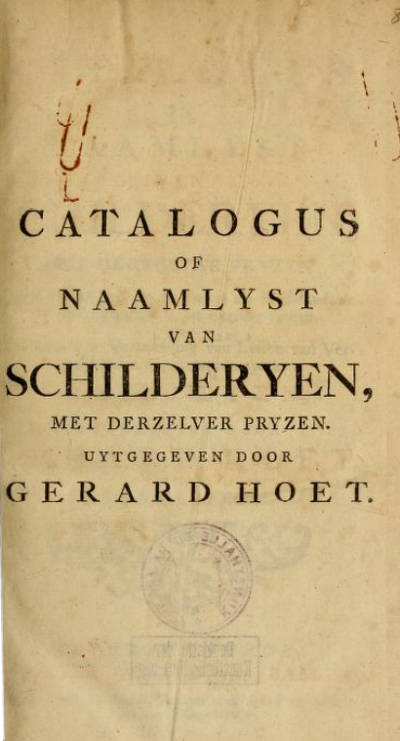 fig. 39 Catalogus of Naamlyst van Schilderyen, met derzelver Pryzen (cover),
fig. 39 Catalogus of Naamlyst van Schilderyen, met derzelver Pryzen (cover),Gerard Hoet II
1752
The Hague
The Catalogus (fig. 39) is notable for its detailed records of painting sales, including prices, at auctions across the Netherlands and elsewhere. Such detailed documentation offers invaluable insights into the era's art market, revealing the popularity and commercial valuation of various artists and their works. Apart from auction records, Hoet's work also includes descriptions of various art collections (cabinetten) that were in existence at the time. These lists offer a glimpse into the collecting habits and preferences of art connoisseurs and collectors during the eighteenth century.
In addition, Hoet's catalogue is a crucial resource for art historians, providing a wealth of information that helps in the provenance research of artworks, understanding the historical art market, and studying the reception of artists and their works over time. It helps to trace the movement of artworks through the centuries and offers context for their valuation and appreciation.
Hoet himself was an accomplished painter, which adds an interesting layer to the catalogue.
For Vermeer specialists, the chief importance of the so-called "Dissius auction" 1696 Amsterdam auction of twenty-one paintings by Vermeer lies in the catalogue descriptions of the pictures (fig. 40). It comprises one of the few solid historical foundations scholars have for determining which are genuine Vermeer paintings and which are not. While some auction descriptions are too vague to be useful, fifteen or sixteen of the twenty-one listed paintings have been identified with reasonable certainty today. Elisabeth Neurdenburg was the first to establish a link between the paintings listed in Hoet's catalogue and the art collection owned by Jacob Dissius. Jacob Dissius, a Delft printer, was married to Magdalena van Ruijven—the daughter of Vermeer's main patrons, Pieter van Ruijven and his wife, Maria de Knuijt.Neurdenburg, Elizabeth. "Johannes Vermeer. Eenige opmerkingen naar aanleiding van de nieuwste studies over den Delftschen Schilder." Oud Holland 59, no. 3 (1942).
 fig. 40 Catalogus of Naamlyst van Schilderyen, met derzelver Pryzen,
fig. 40 Catalogus of Naamlyst van Schilderyen, met derzelver Pryzen,Gerard Hoet II
1752
The Hague, pp. 34 & 35
Houbraken, Arnold. De groote schouburgh der Nederlantsche konstschilders en schilderessen, 3 delen, Amsterdam 1718-1721.
Arnold Houbraken (1660–1719) was a Dutch painter, writer, and art historian in the late seventeenth and early eighteenth centuries. He is best known for his work as an artist biographer, particularly for his authorship of De Groote Schouburgh der Nederlantsche Konstschilders en Schilderessen (The Great Theatre of Dutch Painters and Paintresses), a three-volume series that remains an essential resource for the study of Dutch Golden Age painting. This monumental work, published between 1718 and 1721, shortly before and after his death, compiles biographies of Dutch artists from the sixteenth to the eithteenth century, offering invaluable insights into their lives, works, and contributions to art history.
Houbraken's biographies are noted for their detailed accounts of artists' lives, their mentors, their students, their artworks, and city histories, making him a pivotal figure in the field of art history. However, while Houbraken's work is an indispensable resource for understanding Dutch art of the period, his accounts are sometimes criticized for their inaccuracies and reliance on anecdotal evidence, which was common in biographical writing of his time.
Houbraken's De Groote Schouburgh sold quite well during the entire eighteent century. Jacob Campo Weyerman published his updated version (1729–1747) in serial form that was published as a complete set in 1769. Houbraken's engravings of the artists are in some cases the only surviving portraits of these people.
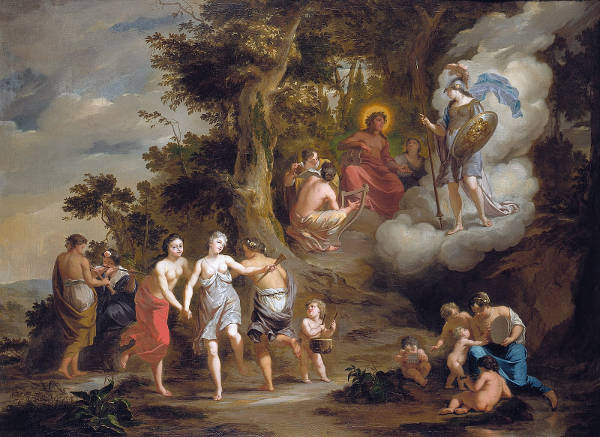 fig. 41 Pallas Athene Visiting Apollo on the Parnassus
fig. 41 Pallas Athene Visiting Apollo on the ParnassusArnold Houbraken
1703
Oil on canvas, 71 x 96 cm.
Dordrechts Museum, Dordrecht
In addition to his biographical work, Houbraken was also a skilled painter (fig. 41), although his reputation as an artist has been overshadowed by his contributions as an art historian. His paintings typically followed the Baroque style, prevalent among his contemporaries in the Dutch Golden Age of painting.
While at the time Vermeer was not totally isolated, his fame did not reach far. To Houbraken, Vermeer was but a name, with only his birthdate recorded in the comprehensive lexicon of Dutch artists. Living in Dordrecht until between 1705 and 1710, Houbraken likely missed the Dissius auction, which could explain his unfamiliarity with Vermeer's oeuvre. A contributing factor to Houbraken's neglect was his method of compiling information about Dutch artists. While well informed about artists in Amsterdam and from his native Dordrecht, he drew on other sources for information about artists from other cities.
For Delft artists, Houbraken primarily relied on Bleyswijck's Beschryvinge der Stadt Delft, which listed only artists born in Delft and deceased by 1667 and therefore contained merely a reference to Vermeer's birthplace (see vol. 1, p. 236) (fig. 42). Houbraken, merely copied van Bleyswijck's list of artists, and dropped the last stanza of Bon's poem to Fabritius, and makes no other reference to Vermeer.
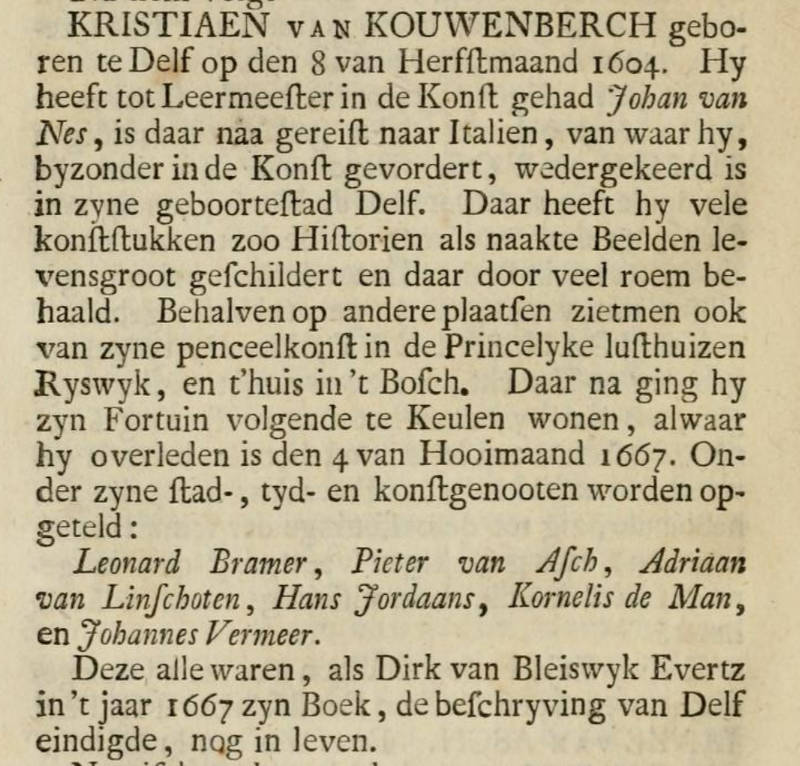 fig. 42
fig. 42 De groote schouburgh der Nederlantsche konstschilders en schilderessen (detail)
Arnold Houbraken
Volume 1, page 236
Amsterdam : 1718–1721.
This omission seemingly dealt a significant blow to Vermeer's posthumous reputation. Throughout the remainder of the eighteenth century, no biography of Vermeer was published—a fact that occasioned the amazement of Henry Havard in 1883.The first scholar to attempt to placate this somewhat romanticized outrage was Albert Blankert, in 1976).Ben Broos, "Un célèbre Peintre nommé Verme[e]r," in Vermeer, edited by Albert Blankert, Gilles Aillaud, and John Michael Montias, (Woodstock and New York: Overlook Duckworth, 2007), 52. While some have speculated that Houbraken bore a grudge against Vermeer, a more plausible explanation is an accidental oversight. Had Houbraken consulted van Bleyswijck's Beschryvinge, he may have inadvertently overlooked the page detailing Fabritius (page 853), and thus, missed the stanza praising Vermeer, on the next page (page 854), of the Arnold Bon poem that acclaimed Vermeer.Anthony Bailey, Vermeer: A View of Delft (New York: Holt Paperbacks, 2002), 213.
https://archive.org/details/jbc.bj.uj.edu.pl.NDIGSTDR029813Le Brun, Jean-Baptiste Pierre. Galerie des peintres flamands, hollandais et allemands, Paris, 1792–1796.
Jean-Baptiste Pierre Le Brun (1748–1813) was a French art connoisseur, dealer, traveler, and writer who played a significant role in the art world of late eighteenth and early nineteenth-century France. By 1792, Le Brun had traveled twenty-three times to the Low Countries. Through contacts with local dealers and art collectors, he acquired an incomparable knowledge of Dutch painting. At the same time he must have become acquainted with the growing appreciation of Vermeer among discerning connoisseurs and collectors. Consequently, between 1792 and 1796, Le Brun released Galerie des peintres flamands, hollandais et allemands, a detailed survey of Northern school painters. In the Table alphabétique he listed 1,350 Flemish, Dutch and German artists known to him at that time. He made a selection of the 157 best and most collectible painters, whom he discussed individually. From the works of these selected masters Le Brun had a total of 201 paintings engraved. The vast editorial project was published in both Paris and Amsterdam, and was partly financed by Pierre Fouquet Jr., Le Brun's principal business partner in the Netherlands.
Although the role of Le Brun in the "rediscovery" of Vermeer has always been eclipsed by that of Thoré-Bürger's (1807–1869), recent studies by Peter WesterPeter Wester, "'A mere pre-discovery or a meaningful découverte?'": The early discovery of Johannes Vermeer by Jean-Baptiste Pierre Le Brun," Essential Vermeer, August 2015, accessed February 6, 2024. have illuminated Le Brun as the primary promoter of Vermeer's work, highlighting his enduring impact on the art world.
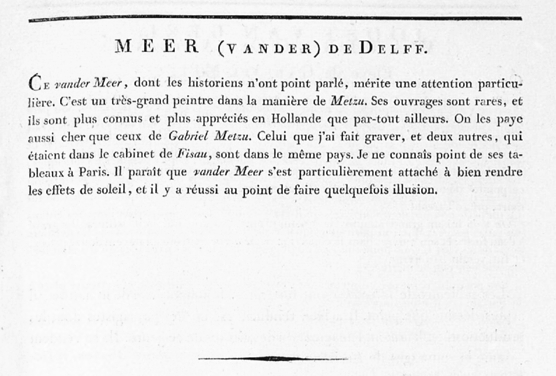 fig. 43 Galerie des peintres flamands, hollandais et allemands (Volume 2: p. 49)
fig. 43 Galerie des peintres flamands, hollandais et allemands (Volume 2: p. 49)Jean-Baptiste Pierre Le Brun
Paris, 1792–1796
Vermeer's reputation during his lifetime was relatively discreet but had some recognition in and around Delft. Le Brun, a skilled connoisseur and art critic, changed the course of Vermeer's recognition in the late eighteenth and early nineteenth centuries. The following considerations are drawn from Wester's article, "'A mere pre-discovery or a meaningful découverte ?'": The early discovery of Johannes Vermeer by Jean-Baptiste Pierre Le Brun," 2015.
Through his extensive travels in the Low Countries and deep involvement in the art world, Le Brun acquired unparalleled knowledge of Dutch painting. One of his goals was to promote lesser-known artists and encourage the appreciation of rarity and unfamiliarity in art. In the Galerie, he highlighted Vermeer as a remarkable artist, comparing him to Gabriel Metsu (1629–1667), at that time one of the most then highly esteemed Dutch seventeenth. century artists. He noted (fig. 43):
This van der Meer, about whom historians haven't spoken at all, deserves special attention. He is a very great painter in the manner of Metzu. His works are rare and better known and appreciated in Holland than anywhere else. They are paid for the same as the works of Gabriel Metzu. The one that I have had engraved, and two others, which are in Fisau's cabinet, are in the same country. I don't know a single work in Paris. It seems that van der Meer was primarily preoccupied with rendering sunlight effects, to the point of sometimes achieving illusion.
One notable achievement was Le Brun's commissioning of an engraving of Vermeer's The Astronomer in 1784 (fig. 44), marking the first time Vermeer's work was reproduced. This move contributed to raising awareness of Vermeer's art.
In Recueil de gravures au trait (1809), Le Brun published a series of simplified engravings of paintings which he said to have purchased during a journey in 1807 and 1808. In the Recueil he discussed Vermeer's Mistress and Maid, the second work by the artist ever to be reproduced (fig. 45). In total, two Vermeer paintings had gone through Le Brun's hands. Le Brun acquired the Mistress and Maid and A Maid Asleep, the latter of which he sold in 1811.
However, Le Brun's influence extended beyond his writings. Vermeer's paintings began to appear more frequently in auction descriptions, often referencing Le Brun's work. In a 1806 sale, he even attributed a painting to Vermeer, indicating growing familiarity with the artist among art professionals.
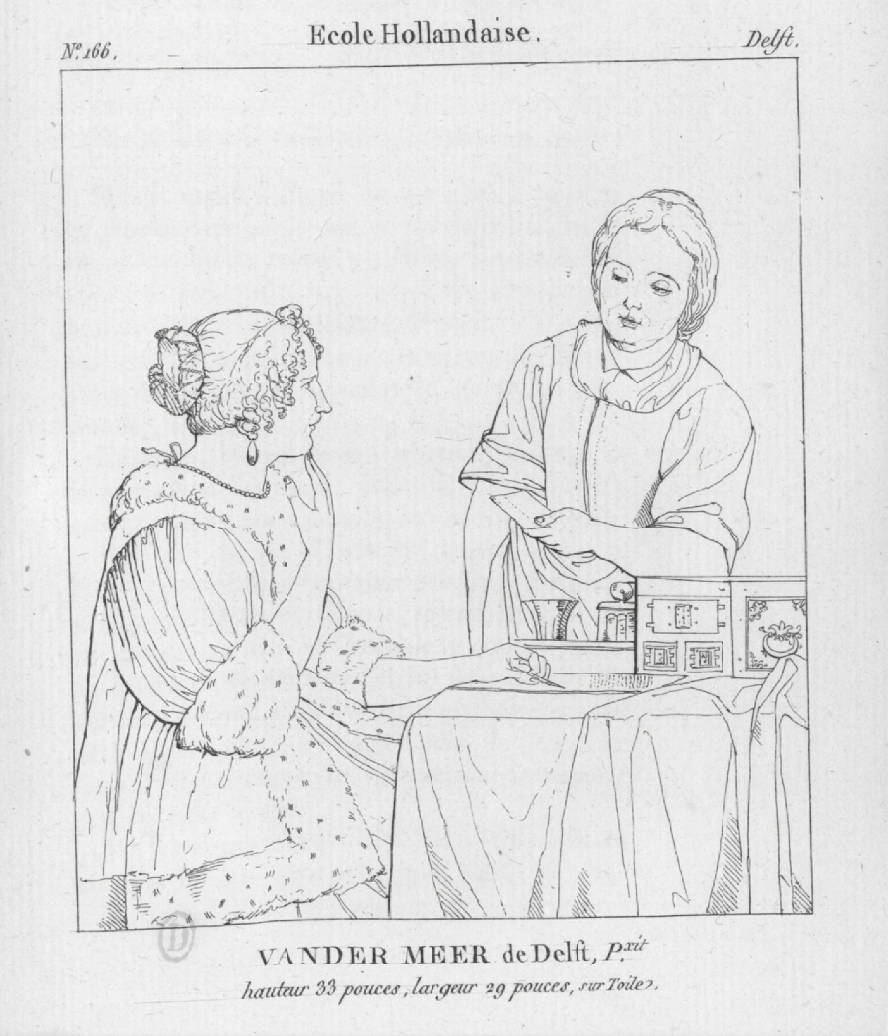 fig. 45 Mistress and Maid
fig. 45 Mistress and MaidRecueil de Gravures au Trait, a l'eau Forte, et Ombrées, d'après un choix de tableaux de toutes les écoles, recueillis dans un voyage fait en Espagne, au midi de la France et en Italie, dans les années 1807 et 1808.
Ecole Hollandaise No. 166
M. Lebrun
Engraving
Editore: A Paris: De L'Imprimerie de Didot Jeune, 1809
Despite these developments, Vermeer's work remained limited in availability and public display until the early nineteenth century. In 1816, the Geschiedenis der vaderlandsche schilderkunst (History of Painting of the Fatherland; 1816)The Geschiedenis der Vaderlandsche Schilderkunst, often called Van Eynden and Van der Willigen, is a 19th-century dictionary of artist biographies from the Netherlands published 1816-1842. The reference work was started by Roeland van Eynden, a painter and writer from the Northern Netherlands, as a follow-up to the work published by Arnold Houbraken and Jan van Gool. The work was published first in two volumes listing painters active before 1800. The third volume was published with contemporary painters, and it was finished after Van Eynden's death by publishing a 4th volume with corrections and additions which was written by his friend and colleague, Adriaan van der Willigen, a Dutch writer known for his travelogues. praised Vermeer, and in 1822, View of Delft became accessible to the public, further contributing to his recognition.
Subsequent mentions by John Smith in 1833 and Thoré-Bürger's 1840s publications significantly contributed to Vermeer's resurgence. Thoré referenced Le Brun's earlier contributions but strategically emphasized Vermeer's obscurity during the preceding century for dramatic effect.
De Vries, Jeronimo. Notes on Vermeer, 1813.
Another champion of Vermeer in the period of Vermeer's resurgence was Adriaen van der Willigen's (1766–1841) friend, Jeronimo de Vries (1776–1853), a Dutch civil servant, art dealer, auctioneer, publicist, art critic, and art collector, who in an essay of 1813 recommended Vermeer as an exemplary genre painter.(see P. Hecht, "Candlelight and dirty fingers, or royal virtue in disguise: some thoughts on Weyerman and Godfried Schalcken," in Simiolus 11, 1980, 23, note 4
De Vries was primarily active in Amsterdam, and was a joint organizer of the auction house "Huis met de Hoofden." In a letter dated April 1, 1821, De Vries wrote to Van der Willigen that he had visited Jan Pieter Teding van Berkhout (1785–1825), Teding van Berkhout's (1643–1713) relative, to negotiate the sale of a number of paintings. In addition to several less important works, he was especially interested in two masterpieces: Vermeer's View of Delft and Meindert Hobbema's Ruins of Brederode Castle (National Gallery, London). The sale, which topok place in 1822, was known to the outside world simply as the S.J. Stinstra Collection. De Vris opined, "In my view they are well suited to the Rijksmuseum, providing people remain reasonable." Six months later, De Vries, impatient, again wrote to Van der Willigen: "Where is now Hobbema; where the van der Meer?"
De Vries also represented the most important Dutch woman collector of the time, Jonkvrouwe Lucretia Johanna van Winter (1785–1845), who on de Vries's indications paid no less than 2,125 guilders for The Milkmaid.Lucretia Johanna van Winter was known within the cultural circles of Amsterdam's elite as an important collector of paintings. She owned and bought absolute masterpieces, including Johannes Vermeer's The Milkmaid. Van Winter's collection grew along with the rise of national consciousness. Whereas around 1800 the focus was still mainly on the Old Masters, during the nineteenth century the idea developed that the acquisition of contemporary art from one's own country should be encouraged. Lucretia Johanna van Winter also bought dozens of contemporary paintings. In doing so, she was helped by art broker Jeronimo de Vries (1776-1853). Moreover, thanks to her many trips abroad, Lucretia was well informed about the latest trends in painting, as can be seen in her travel diaries. Shannon van Essen, RKD podcast: Lucretia Johanna van Winter, RDK, accessed February 18, 2024. https://www.rkd.nl/en/knowledge-publications/podcasts/rkd-podcast-lucretia-johanna-van-winter
The foundation of Van Winter's exceptional collection was laid in 1807 when she and her sister Annelies inherited halves of their father Pieter de Winter's renowned collection, which included Vermeer's The Little Street, by Vermeer (Rijksmuseum, Amsterdam), and probably the finest picture that Bartholomeus Breenbergh ever painted, The Preaching of John the Baptist, of 1634, in the Metropolitan Museum.Walter Liedtke, The Milkmaid by Johannes Vermeer (New York: The Metropolitan Museum of Art, 2009), 23.
Josi, Christiaan. Collection d'imitations de dessins d'après les principaux maîtres hollandais et flamands. Amsterdam and London: Chez C. Josi, 1821.
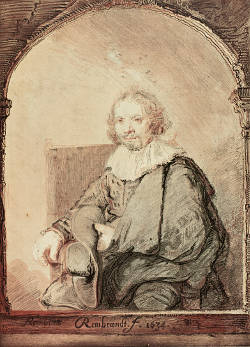 fig. 46 Portrait of a Man in an Arm Chair
fig. 46 Portrait of a Man in an Arm ChairChristian Josi
1821
Soft ground etching, hard ground etching, aquatint, and roulette, printed from two plates in red-brown and black, on ivory laid paper, 37.5 × 27.1 cm.
Art Institue of Chicago, Chicago
Christiaan Josi (1768–1828) was a Dutch engraver, publisher, and art dealer known for his deep engagement with the art world of his time (fig. 46). He was admitted into the Renswoude Foundation in Utrecht and trained in the art of engraving. To further his skills, he was sent to London, where he received instruction from the famous Bartolozzi. After marrying a daughter of the Dutch engraver Jan Challon, who was based in London, he returned to the Netherlands and settled in Amsterdam. There, he engaged in engraving and supervising the engraving of various prints, including those for book titles. Subsequently, he opened a print shop and also traded in old-master paintings. He was known for his extensive art knowledge and became the go-to person for many until he publicly sold his art shop in 1818 and moved to London.
His work spanned various roles, including that of a connoisseur and chronicler of the arts, particularly in the context of the Netherlands. Discours sur l'état ancien et moderne des arts dans les Pays-Bas reflects Josi's endeavor to document and analyze the evolution of art in the Dutch regions, likely addressing changes in artistic styles, notable artists, and the socio-cultural factors influencing art from ancient times through to the modern era of the late eighteenth and early nienteenth centuries.
Josi's volume is considered to be one of the most important productions in the history of illustration. Jacob Ploos van Amstel (1735–1784), the publisher, perfected a method of reproducing paintings that was never revealed to others, and when he died in 1798, he took the secrets of his worsshop with him. It was not until 1821 that his relative and apprentice, Christian, was able to begin publication of the works owned by Ploos. Also noteworthy is the preface, full of historical anecdotes about eighteenth-century collecting and collectors.
Josi was one of the first to articulate the exceptional qualities of Vermeer's oeuvre, of whom "the biographers have never spoken." Around 1800, he wrote: "The paintings of Jan van der Meer…so remarkable for the simplicity of their subject and their truth of expression, were once little known…Today connoisseurs appreciate the works of this master," noting that they were once little known but had since gained appreciation among connoisseurs, such as collectors of Amsterdam who had owned one or more paintings by the master: Pieter van Winter (later his daughter Creejans), Jan Gildemeester, Pieter van Lennep, Jan Danser Nijman, Hendrik Muilman, but also the art dealers, such as Aarnoud de Lange, Pieter Fouquet, and Jan Wubbels. Josi's observations included references to specific works such as The Milkmaid, The Geographer, and he also noted the historical journey of The Astronomer—which he thought to be a self-portrait—, which appeared in the Leopold Double sale in Paris. Despite his extensive knowledge of Vermeer's art, Josi admitted to less familiarity with the artist's life, mistakenly believing the Delft Vermeer was the father of the Utrecht painter—a common confusion given the slight age difference and the Utrecht painter's longer lifespan.The Schipluy/Utrecht van der Meer was not only about two years older than Vermeer of Delft but lived some twenty years longer.
Josi's engagement with Vermeer extended beyond commentary; he actively participated in the art market. In 1798, he wrote that he himself had bought a Vermeer at the Nyman auction: a transaction he later recalled to underscore the rising valuation of Vermeer's work. To substantiate his point, he demonstrated how prices for Vermeer's paintings had risen dramatically in the preceding decades, citing as one example The Geographer, bought in 1798 for "7 louis" and sold in 1803 for "36 louis" Arthur K. Wheelock Jr., Jan Vermeer: Library of Great Painters (New York: Harry N. Abrams, Inc., 1981), 47. (J' achetai chez Nijinan en 1798, l'homme tenant un compas à la main pour 7 louis, et, à la vente de M. de Lange, en 1803, il fut porté à 36 louis [In 1798, I purchased from Nyman a painting of a man holding a compass for 7 louis, and at Mr. de Lange's sale in 1803, it was valued at 36 louis]). Josi's observations were dramatically confirmed the following year when Vermeer's View of Delft was purchased for the Mauritshuis for the extraordinary sum of 2,900 florins. The sales catalogue described it as: "This most important and most famous painting by this master, whose works are seldom available…"
Following Josi's lead, lexicon and catalogue compilers like Van Eijnden, Van der Willigen, and Smith began to acknowledge Vermeer's significance. Josi's assertion that he believed some of Vermeer's pieces, specifically The Astronomer and possibly The Geographer, had found their way to England, speaks to his foresight in the international movement of Dutch art. Despite The Astronomer's brief tenure in the English art trade, The Geographer remained within Dutch collections, highlighting the localized appreciation for Vermeer's genius.
Vand Eynden, Roeland. and Van der Willigen, Adriaen. Geschiedenis der vaderlandsche schilderkunst : sedert de helft der XVIII eeuw. 4 vols., Haarlem 1816–1840 (Volume 1, 1816, pp. 164).
The Geschiedenis der Vaderlandsche Schilderkunst is part of a literary genre dedicated to the documentation and analysis of Dutch painting's evolution and history. Notably, Roeland van Eynden (1747–1819) and Adriaen van der Willigen (1766–1841) have made significant contributions to this field, instrumental in preserving Dutch painting's rich history and legacy These publications provide valuable insights into the lives and works of Dutch artists, their techniques, and the socio-cultural context in which they created their masterpieces.
Often referred to by the names of its authors, Van Eynden and Van der Willigen, the Geschiedenis is a nineteenth-century dictionary of Dutch artist biographies, published between 1816 and 1840.. The reference work was started by Roeland van Eynden, a painter and writer from the Northern Netherlands, and intended as a follow-up to Arnold Houbraken's De groote schouburgh der Nederlantsche konstschilders en schilderessen (The Great Theatre of Dutch Painters and Paintresses),The De groote schouburgh der Nederlantsche konstschilders en schilderessen is a series of artist biographies with engraved portraits written by the 18th-century painter Arnold Houbraken. It was published in three volumes as a sequel to Karel van Mander's own list of biographies known as the Schilder-boeck. The first volume appeared in 1718, and was followed by the second volume in 1719, the year Houbraken died. The third and last volume was published posthumously by Houbraken's wife and children in 1721. This work is considered to be a very important source of information on 17th-century artists of the Netherlands. The Schouburg is listed as one of the thousand most important works in the Canon of Dutch Literature [nl] from the Middle Ages to the present day. and Jan van Gool's Nieuw Schouburghe.The Nieuw Schoubur by Jan van Gool (full title is De Nieuwe Schouburg der Nederlantsche kunstschilders en schilderessen: Waer in de Levens- en Kunstbedryven der tans levende en reets overleedene Schilders, die van Houbraken, noch eenig ander schryver, zyn aengeteekend, verhaelt worden; The Hague, 1750) was intended as an update to the original Schouwburg written by his friend Arnold Houbraken, whose 3-volume Schouburg was written in order of birth year, ending with Adriaen van der Werff, born in 1659. Just as Houbraken before him, Van Gool begins his book with a tribute to his predecessors, most notably Karel van Mander and to Houbraken himself, noting however, that Houbraken included many insulting comments in his sketches that he felt were unnecessary. aZ750) was intended as an update to the original Schouwburg written by his friend Arnold Houbraken, whose 3-volume Schouburg was written in order of birth year, ending with Adriaen van der Werff, born in 1659. Just as Houbraken before him, he starts his book with a tribute to his predecessors, most notably Karel van Mander and to Houbraken himself, noting however, that Houbraken included many insulting comments in his sketches that he felt were unnecessary. Initially published in two volumes, Van Eynden and Van der Willigen's work listed painters active before 1800. A third volume, focusing on contemporary painters, followed, and after Van Eynden's death, a fourth volume of corrections and additions was completed by his friend and colleague, Adriaan van der Willigen, further enriching the narrative with insights from his extensive travels.
Regarding Vermeer specifically, Van Eynden and Van der Willigen wrote (fig. 47):
It is hardly necessary to point out that the works of the so-called Delft van der Meer deserve a place in the most distinguished collections of art. All amateurs of art know that his paintings are ranked with those of the most outstanding masters of the Dutch school, and are paid with great sums. Nor should this cause any surprise if one takes into consideration that, just as Adriaen van Ostade is sometimes called "the Peasant Raphael" for his artful union of the ideal character with the simple imitation of nature, so also Johannes Vermeer may well be called the Titian of the modern painters of the Dutch school, because of his strong colors and easy brush technique.
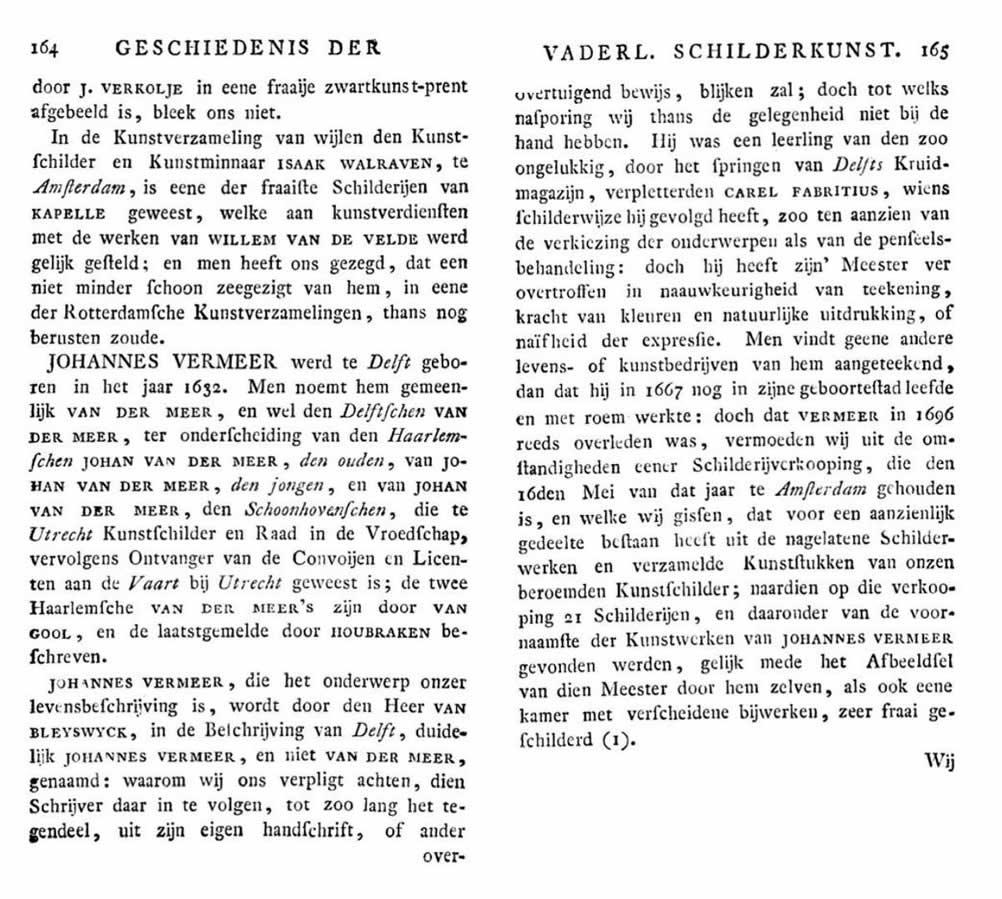 fig. 47 Geschiedenis der vaderlandsche schilderkunst: sedert de helft der XVIII eeuw.
fig. 47 Geschiedenis der vaderlandsche schilderkunst: sedert de helft der XVIII eeuw.4 vols., Haarlem 1816–1840 (Volume 4, 1816, pp. 164-165)
"Remarkably, Van Eynden and Van der Willigen knew only two Vermeers at first hand. The Milkmaid, which they 'saw with exceptional pleasure' noting that 'we must say that we know no other painting of this kind of subject that surpasses it in power and naturalness of expression." The Little Street so impressed them that they wrote that they 'cannot recommend it enough to the attention and judicious imitation of young painters who wish to devote themselves to similar subjects.'"Albert Blankert, "Vermeer and his Public," in Vermeer, edited by Albert Blankert, Gilles Aillaud, and John Michael Montias, (Woodstock and New York: Overlook Duckworth, 2007), 169. The growing national admiration in The Netherlands for Vermeer's art during the early years of the nineteenth century culminated in 1822 with the purchase of View of Delft by the Dutch state for the then colossal sum of 2,900 guilders. It was placed in the Mauritshuis in The Hague, the new location of the Royal Picture Gallery, which had only recently opened to the public.Wayne Franits, Vermeer (Art & Ideas) (London: Phaidon Press, 2015).
Smith, John. A catalogue raisonné of the works of the most eminent Dutch, Flemish, and French painters. Supplement vol. 9, London, 1842.
A Catalogue Raisonné of the Works of the Most Eminent Dutch, Flemish, and French Painters in nine volumes is a significant publication in the field of art history, particularly concerning the study of European painting. John Smith, a British art dealer and connoisseur in the nineteenth century, and his catalogue raisonné is recognized for its comprehensive coverage of notable painters from these regions.
The catalogue, published in several volumes during the early to mid-nineteenth century (specifically from 1829 to 1842), provides detailed descriptions of the works of many important artists from the Dutch, Flemish, and French schools of painting. It covers a wide range of artists, including those from the Dutch Golden Age and the Flemish Baroque period, as well as notable French painters. It was among the first to attempt a systematic and scholarly documentation of the works of these artists. Smith included detailed descriptions of paintings, their provenance, and their critical reception, which was invaluable for collectors, dealers, and historians alike.
The catalogue became a crucial resource for art collectors and dealers in the nineteenth century, influencing the collection and sale of European paintings. It helped in establishing the authenticity and historical significance of artworks. Despite its importance, Smith's catalogue is not without its criticisms. With advances in art historical research and scholarship, some of Smith's attributions and analyses have been revised or questioned. However, his work remains a landmark in the field of art history, providing a foundation upon which later scholars have built ans is still referenced today by art historians and researchers for its early contributions to the documentation of European painting.
Having little knowledge of Vermeer's art, Smith relegated Vermeer among imitators of Gabriel Metsu on page 110 (volume 4) and imitator of Pieter de Hooch on page 242 (volume 4) (fig. 48) . He wrote twenty-five pages are devoted to the life and works of "Peter De Hooge." There follows one page, headed "Scholars and Imitators of Peter De Hooge," and containing three short paragraphs on "Samuel Van Hoogstraten (sic), Joust, or Justus, Van Geel and Vander Meer, of Delf." The author, as we have seen, says of Vermeer:
This painter is so little known, by reason of the scarcity of his works, that it is quite inexplicable how he attained the excellence many of them exhibit. Much of the effect and style of De Hooge is evident in all his pictures, but there are some few which approach that master so nearly, as to create a belief that he studied under him: these pictures generally represent the exterior views of houses. One of his best performances, representing the town of Delft, at sunset, is in the Musee at The Hague. This picture sold in a public sale, about ten years ago, for 5000 flo.
 fig. 48 A catalogue raisonné of the works of the most eminent Dutch, Flemish, and French painters
fig. 48 A catalogue raisonné of the works of the most eminent Dutch, Flemish, and French paintersJohn Smith
Supplement vol. 9, London, 1842 (page 110).
Smith referred to the View of Delft as a remarkable acquisition by King William I, which prompted Ben Broos to write: "Thus, it was King William I (with his advisors) and John Smith, not Thoré-Bürger, who were the true rediscoverers of Vermeer."Ben Broos, "On Celebre Peijntre nommé Verme[e]r," in exh. cat. Johannes Vermeer. Arthur K. Wheelock Jr. and Ben Broos, London and New Haven: Yale University Press, 1995, 52. In addition, "Thore-Burger's dedication is in stark contrast to the matter-of-fact approach of John Smith, whose remarks on Vermeer had put the Frenchman on the trail of the View of Delft."Ben Broos, "On Celebre Peijntre nommé Verme[e]r," in exh. cat. Johannes Vermeer. Arthur K. Wheelock Jr. and Ben Broos, London and New Haven: Yale University Press, 1995, 21.
In 1839, as an art dealer, Smith sold Vermeer's Woman in Blue Reading a Letter to the wealthy Amsterdam banker and art collector Adriaan van der Hoop (1778–1854) for the sum of seventy-three pounds and ten shillings, unaware of Vermeer's fame. Hoop had been a partner of the famous banking house Hope & Co. since 1840, after the directors of this firm (the heirs of its founder John Hope) had fled Holland during the French occupation. Van der Hoop made his fortune quickly, becoming a millionaire by about 1840. In September of 1839 he "made a trade in London with]. Smith & Sons, having bought from him…a good painting by the Delft van der Meer, representing a reading woman dressed in blue."
Théophile Thoré, Etienne Joseph, "Van der Meer de Delft," Gazette des Beaux Arts, Oct. 1, 1866, pp. 297–330; Nov. 1, 1866, pp. 458–470; Dec. 1, 1866, pp. 542–575)
from: Dictionary of Art Historians<https://arthistorians.info/thoret>
The "rediscovery" of Vermeer is predominantly attributed to scholar, collector, French Salon critic and co-founder of L'Alliance des arts, Etienne Joseph Théophile Thoré (1807–1869), sometimes, Thoré-Bürger, Thoré or Willem Bürger. Thoré wrote criticism beginning in the 1830s, during the regime of the July Monarchy (1830–1848). By the 1840s his art criticism was wide ranging encompassing aesthetic and political views. He extolled the work of Eugène Delacroix, Théodore Rousseau and other Barbizon school painters, chiding the conservative painters such as Jean-Auguste-Dominique Ingres as well as the more popular artists such as Paul Delaroche and Horace Vernet. In 1842 he and Paul Lacroix (1806–1884) founded a private agency to sell and promote art, the Alliance des Arts.Also known as the Société de l'Alliance des Arts, a French association founded in 1842 with the aim of promoting a union of all the arts: architecture, sculpture, painting, music, and poetry. The idea was to encourage collaboration between these various disciplines to achieve greater artistic harmony. This aspiration to unite the arts was not unique to this society but was part of a larger 19th-century movement that sought to break down barriers between different art forms. Such interdisciplinary collaborations and movements were responses to rapid industrialization and urbanization during that period. Artists and thinkers were exploring ways to create more holistic artistic experiences that could counterbalance the fragmenting effects of modern life. The Alliance des Arts might not be as renowned today as other artistic societies from the same period, but it was indicative of broader trends and discussions happening in the artistic communities of 19th-century Europe. They also published a Bulletin. Between 1844–1848 Thoré was the art critic for Le Constitutionnel. Because of his support of some of the radicals in the 1848 revolution, (he was a Saint-Simonist and exponent of Pierre Leroux, 1797–1871) was forced into exile in 1849. He returned in 1859, continuing to write under the government of Second Empire. After living in London, Brussels, and in Switzerland, he returned in 1859, continuing to write under the government of Second Empire (1851-1870). In 1855, he began using the Dutch-sounding pseudonym "Willem Bürger," focusing his writing on northern European art. An active archival researcher and connoisseur, he is credited with the rediscovery of Johannes Vermeer and significant re-evaluations of of other seventeenth-century Dutch artists, including Frans Hals.
His criticism derided French baroque painting as too heavily influenced by Italy, terming it as inauthentic of a national identity. He lauded Dutch seventeenth-century naturalism and what has subsequently come to be seen as the acme of Netherlandish painting, the art of the Dutch Republic. It's direct appeal to simple human virtues, he declared made it an art for the people ("l'art pour l'homme"). He continued to deplore the dark history painting of the Academie and the Second Empire, particularly that of Jean-Léon Gérôme and Alexandre Cabanel, in favor of Realism painter such as Gustave Courbet (his favorite), Jean-François Millet, and the Impressionists Edouard Manet, Claude Monet, and Auguste Renoir. As early as 1860, Thoré began purchasing Vermeer paintings. A Lady Standing at a Virginal (1672–1673, National Gallery, London) was acquired sometime before 1876, Woman with a Pearl Necklace (1664, Berlin, Gemäldegalerie) was bought from Henry Grevedon in June 1866. A Lady Seated at a Virginal (1675, National Gallery, London) was purchased for a mere two thousand francs in 1867. The sale of his collection by in 1892 brought the Vermeers and other works into more public collections.
This discovery marked a turning point for Thoré, who became determined to bring recognition to Vermeer. He embarked on an exhaustive quest to locate Vermeer's paintings in museums and private collections across the Netherlands. Thoré's devotion to Vermeer was unwavering, even bordering on obsession. He acquired numerous paintings, some already attributed to Vermeer, and sought validation from experts in various cities.
While Thoré claimed to have found over 72 Vermeer paintings, modern art historians recognize fewer than 36, with doubts that the artist created more than 60 in his lifetime. Nevertheless, Thoré is credited with being the first to appreciate Vermeer's quiet beauty, rescuing him from obscurity, and laying the groundwork for future Vermeer scholarship. In essence, to appreciate Johannes Vermeer's art today is to acknowledge Théophile Thoré's significant role in preserving and promoting his work.
Nonetheless, "Thoré did not immediately succumb to Vermeer. When he had first seen the View of Delft in 1842, he thought its impasto excessive, and this remained his verdict in 1858 in his first published reaction to the painting. Then he wrote of Vermeer's picture: 'One could say that he wanted to build his city with a trowel and that his walls are of real mortar. Enough is enough. Rembrandt never committed such excesses.' But by 1860, Thoré—at that point a collaborator with Gustav Waagen (1797–1868) on a book about Dutch and Flemish painters—was resisting such construction-material metaphors and had begun to admit that he had failed to give the View of Delft and its painter their due. Now he was caught by the Vermeer fire and wanted to know all he could about the mysterious Delft master. His exile had given him the chance to dig—not very deeply—in the Delft archives. He visited the galleries in most European cities, looking for signatures on likely pictures. He spent large sums on photographs of paintings. In libraries he was able to 'read, in all languages, books on art, and attempt to untangle somewhat the still confused history of the Northern Schools, especially the Dutch School, of Rembrandt and his circle—and my "sphinx" van der Meer'.!"Anthony Bailey, Vermeer: A View of Delft (New York: Holt Paperbacks, 2002), 219.
Baburen, Dirck van (or studio of) - A Roman Charity and The Procuress
 fig. 49 Cimon and Pero (Caritas Romana)
fig. 49 Cimon and Pero (Caritas Romana)Dirck van Baburen (studio)
c. 1622–1624
Oil on canvas, 120.5 × 93.5 cm.
Private collection
As far as we know, after Vermeer's death in 167only two objects closely associated with the artist's life seem to have survived—apart from his 35 (?) paintings. According to the Vermeer expert Gregor Weber, one is a painting representing A Roman Charity by Dirck van Baburen (fig. 49), currently in private hands, and a Procuress, by Dirck van Baburen or a follower. Presumably, both were part of a discreet art collection owned Vermeer's well-to-do mother-in-law, Maria Thins.
In a manner similar to The Concert, Vermeer included the former work in a large, black-framed painting in the background of The Music Lesson, albeit without displaying it in its entirety. The visible section of this painting allows us to identify the depicted scene. Like Van Baburen's Procuress, this painting is also mentioned in connection with the divorce of Maria Thins and thus came into the possession of Vermeer's family no later than 1661. The depiction is based on the story of Caritas Romana (Roman Charity): an elderly man, Cimon, is incarcerated and condemned to death by starvation, but his daughter, Pero, prevents this by secretly breastfeeding him.
This Caravaggist picture, possibly based on an original by Gerrit van Honthorst or Matthias Stomer, was already owned by Maria Thins in Gouda and appeared in the inventory list when she and her husband legally separated. Vermeer has only depicted about two-fifths of this Roman Charity, mainly showing the back of Cimon's head and his chained arms as he sucks his daughter's breast, which we know to be happening but cannot see. What significance does this background painting hold for the scene being represented?
"Depictions of this moving story of filial devotion often carry erotic undertones, particularly in works by Caravaggio and his followers. The section Vermeer chose to depict shows the back of the restrained Cimon and the left-facing head of Pero, who, in keeping with this subject, is keeping watch in fear of being discovered by prison guards. While Vermeer discreetly conceals the act of breastfeeding from the naked breast, he positions a milk-white jug directly below the painting-within-a-painting, hinting at a connection between the wall painting and the individuals at the virginal, similar to The Concert. Just as Cimon and Pero are eventually discovered by a guard, here too an unseen observer is present with the couple at the instrument—the artist himself. In the upper part of the mirror above the virginal, one can discern the crossbar and one leg of Vermeer's easel, mirroring its appearance in The Art of Painting. His observational perspective aligns with ours."Gregor Weber, "At a Distance," in VERMEER, ed. Pieter Roelofs & Gregor Weber, Rijksmuseum, Amsterdam, 2023, 188.
The second work, a Procuress, is present in the background of two works by Vermeer, The Concert and the late Lady Seated at a Virginal.
The painting shows three figures: a prostitute on the left, the client in the middle and the procuress on the right pointing to her palm to indicate that she is expecting payment. The client is holding a coin between his fingers as he puts his arm around the prostitute, who is playing a lute. The painting is an example of the popular genre known as bordeeltjes (brothel scenes). The cropped, close-up figures close to the picture plane against a flat blank background are typical of Utrecht Caravaggism.
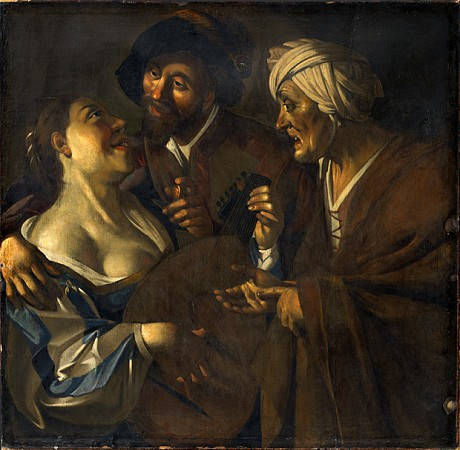 fig. 52 The Procuress
fig. 52 The ProcuressAfter Dirck van Baburen (presumably Han van Meegeren)
1622
Courtauld Gallery, London
There are, however, at least three versions of the painting. The versions in the Rijksmuseum in Amsterdam (fig. 50) and the Museum of Fine Arts (fig. 51), Boston are attributed to Dirck van Baburen or his studio. One copy of the painting was owned by Maria Thins, mother-in-law of Johannes Vermeer, who reproduced it in the background of two of his own paintings. A copy owned by the Courtauld Institute in London (fig. 52) has been identified as the work of the forger Han van Meegeren.
One of these paintings was owned by Vermeer's mother-in-law, and it may have been an influence on one of Vermeer's own early paintings on a similar subject. It also appears in the background of two of Vermeer's later paintings, The Concert and Lady Seated at a Virginal. In both of these later paintings the blatant lust depicted by Baburen is contrasted with the genteel, but erotically charged, middle-class world occupied by Vermeer's women. The contrast between the images may also imply a more general association between music and love. Vermeer sets up a series of contrasts between his own delicate, restrained style and Baburen's vulgar realism. According to Michael Wayne Cole and Mary Pardo, this represents Vermeer's own move away from such low-life subjects. The older, cruder style of Baburen is relegated to the background, "eclipsing it with the more modern kind of genteel subject that Vermeer would soon paint exclusively."Michael Wayne Cole and Mary Pardo, Inventions of the Studio, Renaissance to Romanticism (Chapel Hill: UNC Press Books, 2005), 206.
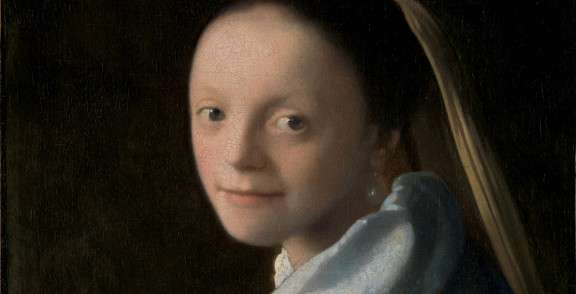



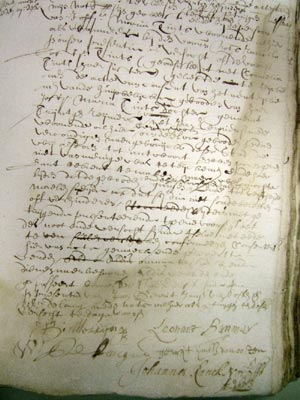

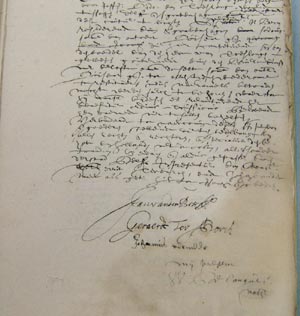
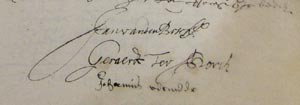
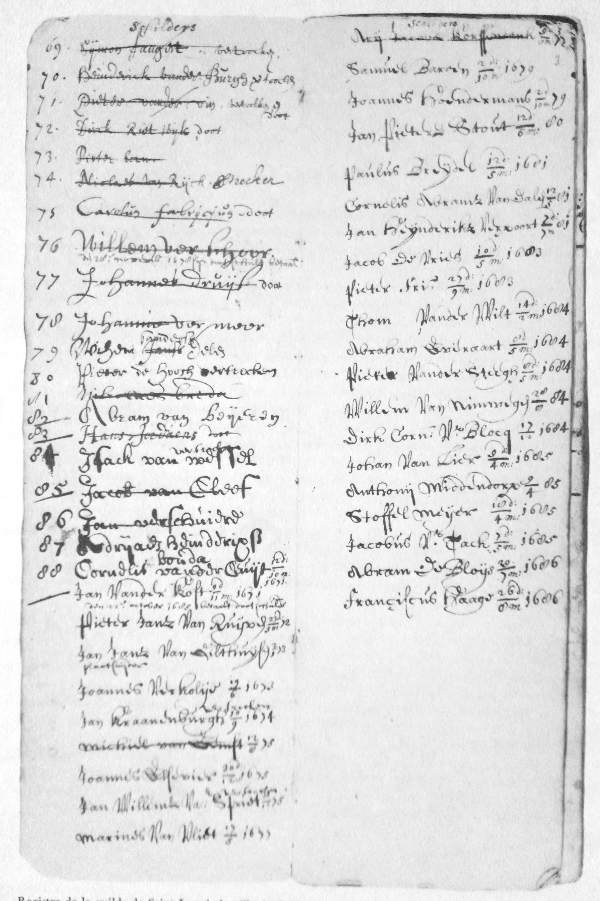 fig. 14 Registration of Johannes Vermeer in the Book of Masters of St. Luke's Guild, 29 December 1653, paper, Royal Library, The Hague
fig. 14 Registration of Johannes Vermeer in the Book of Masters of St. Luke's Guild, 29 December 1653, paper, Royal Library, The Hague
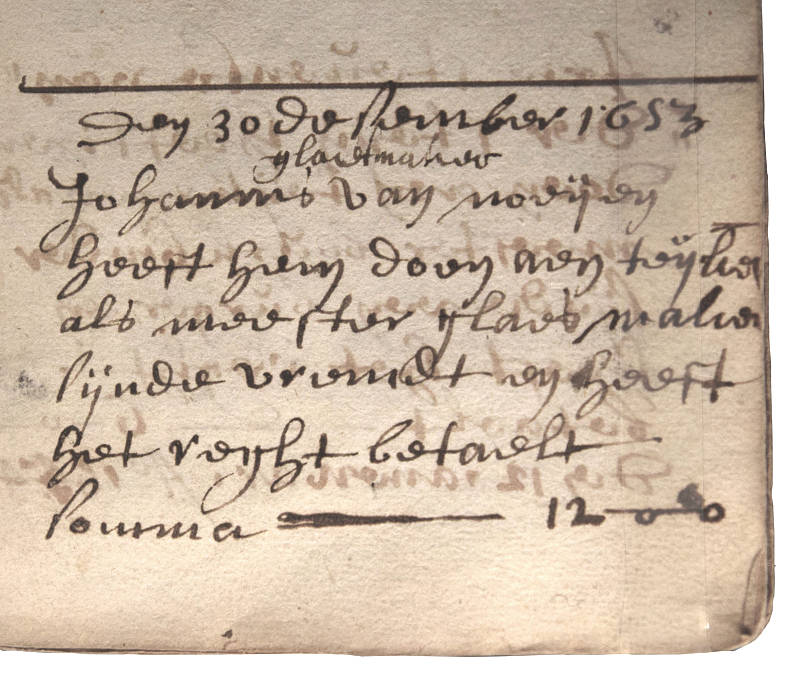

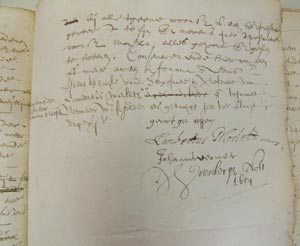

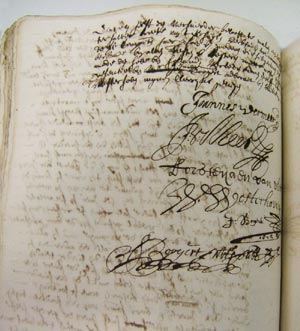
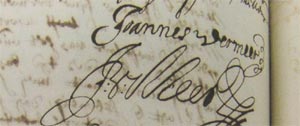
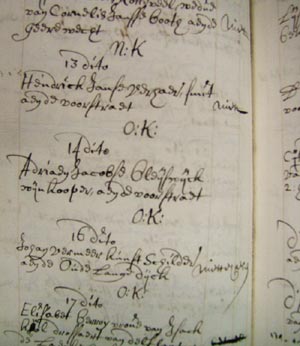
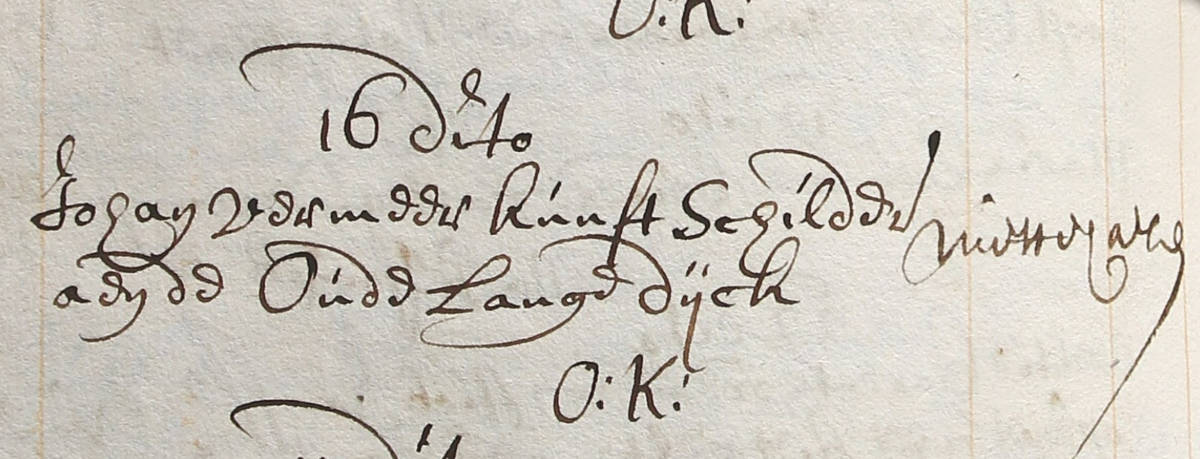
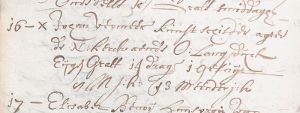
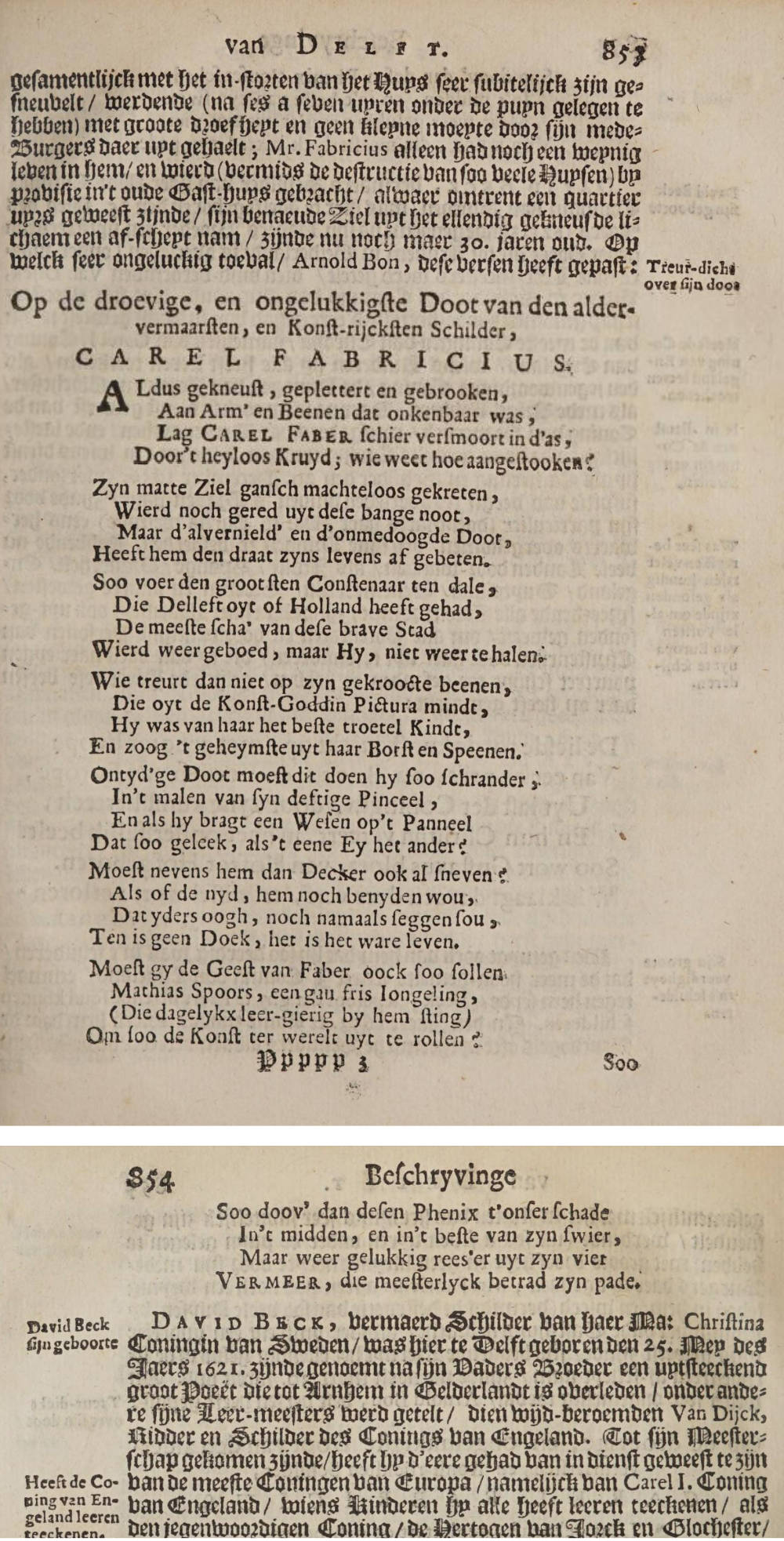

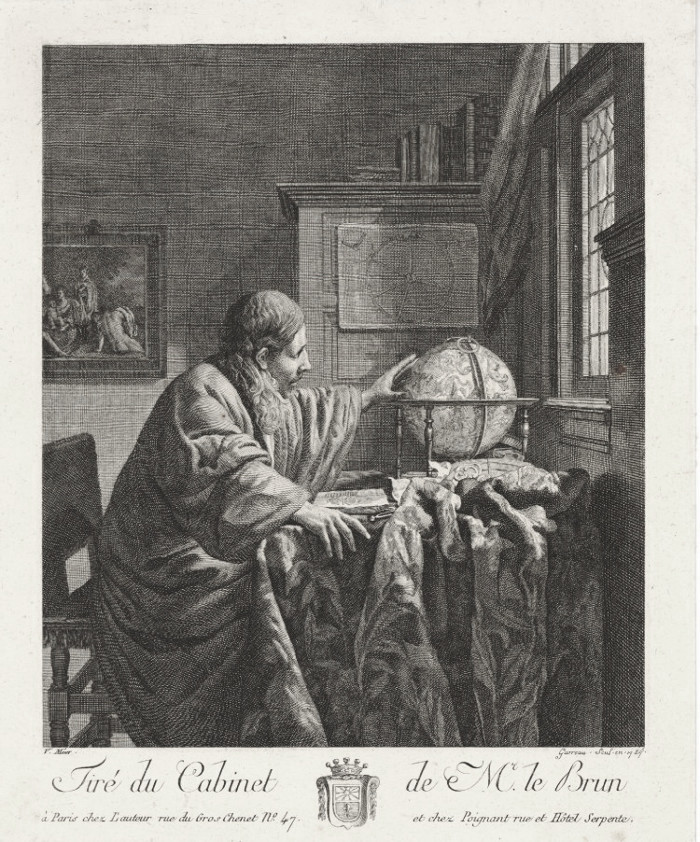
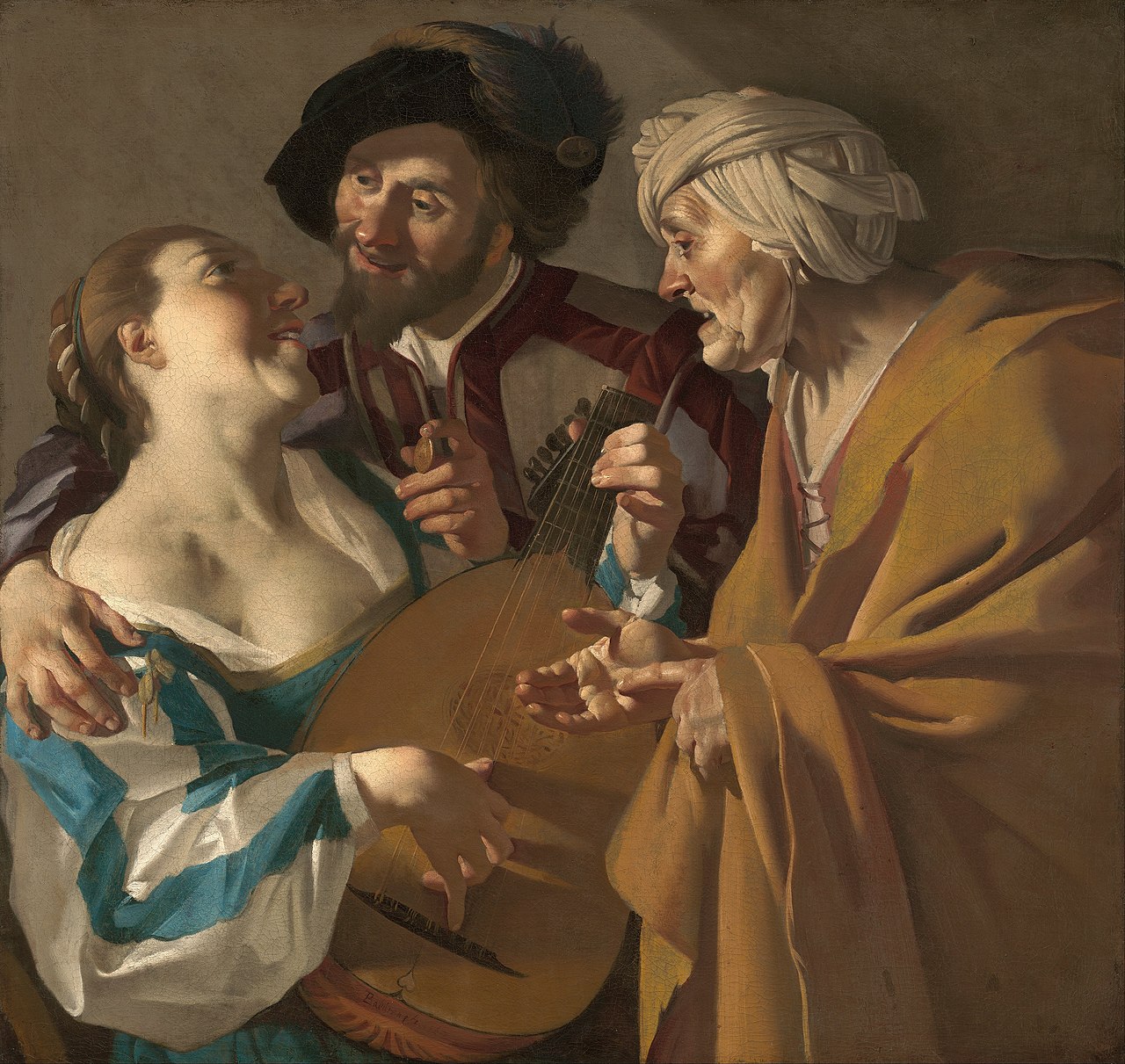

 or anything else that isn't working as it should be, I'd love to hear it! Please write me at:
or anything else that isn't working as it should be, I'd love to hear it! Please write me at: